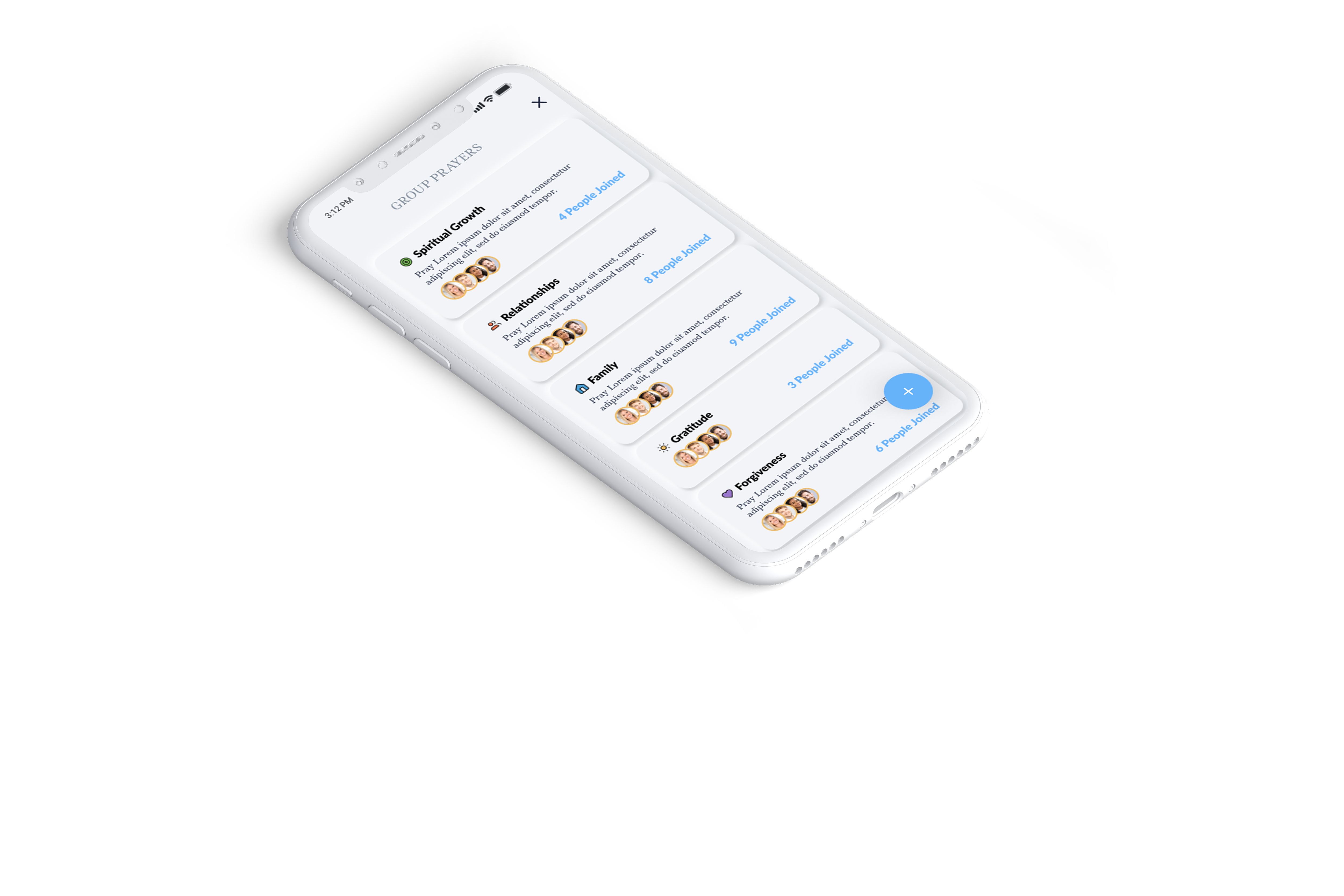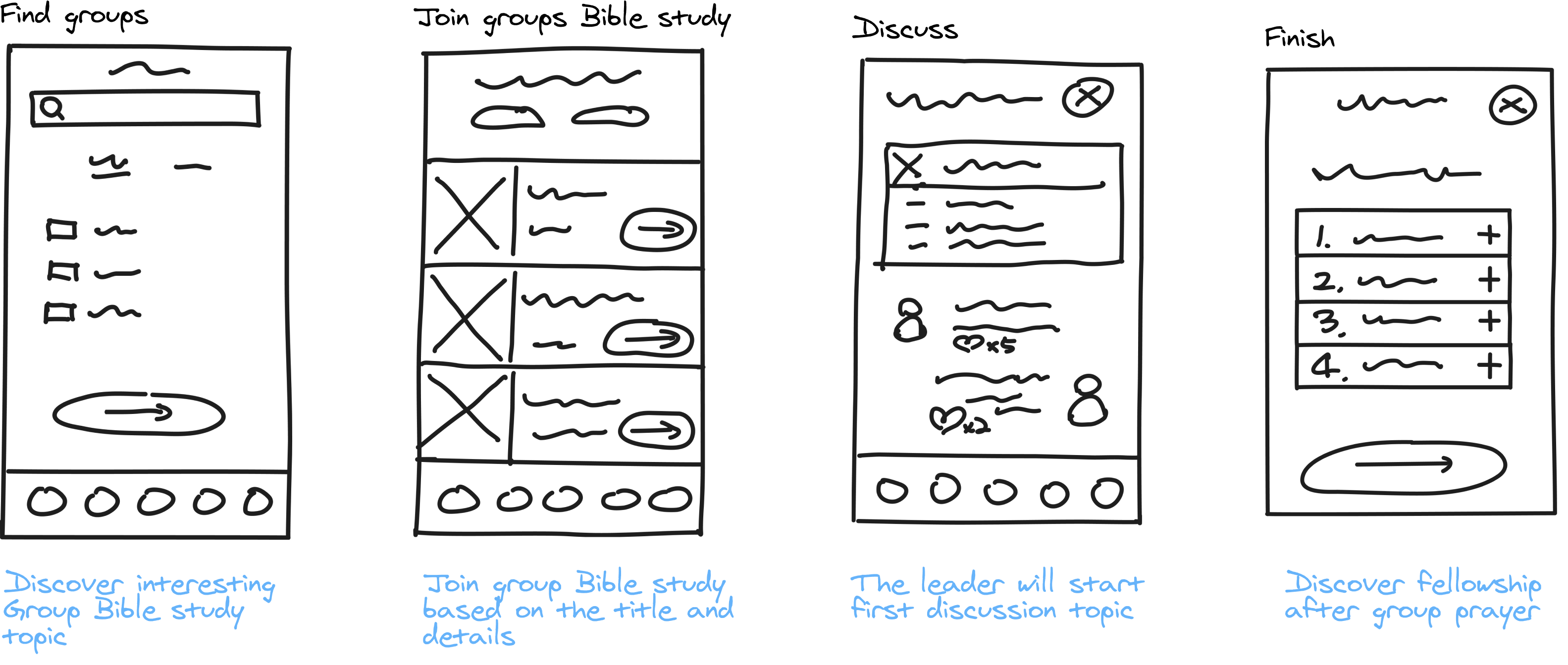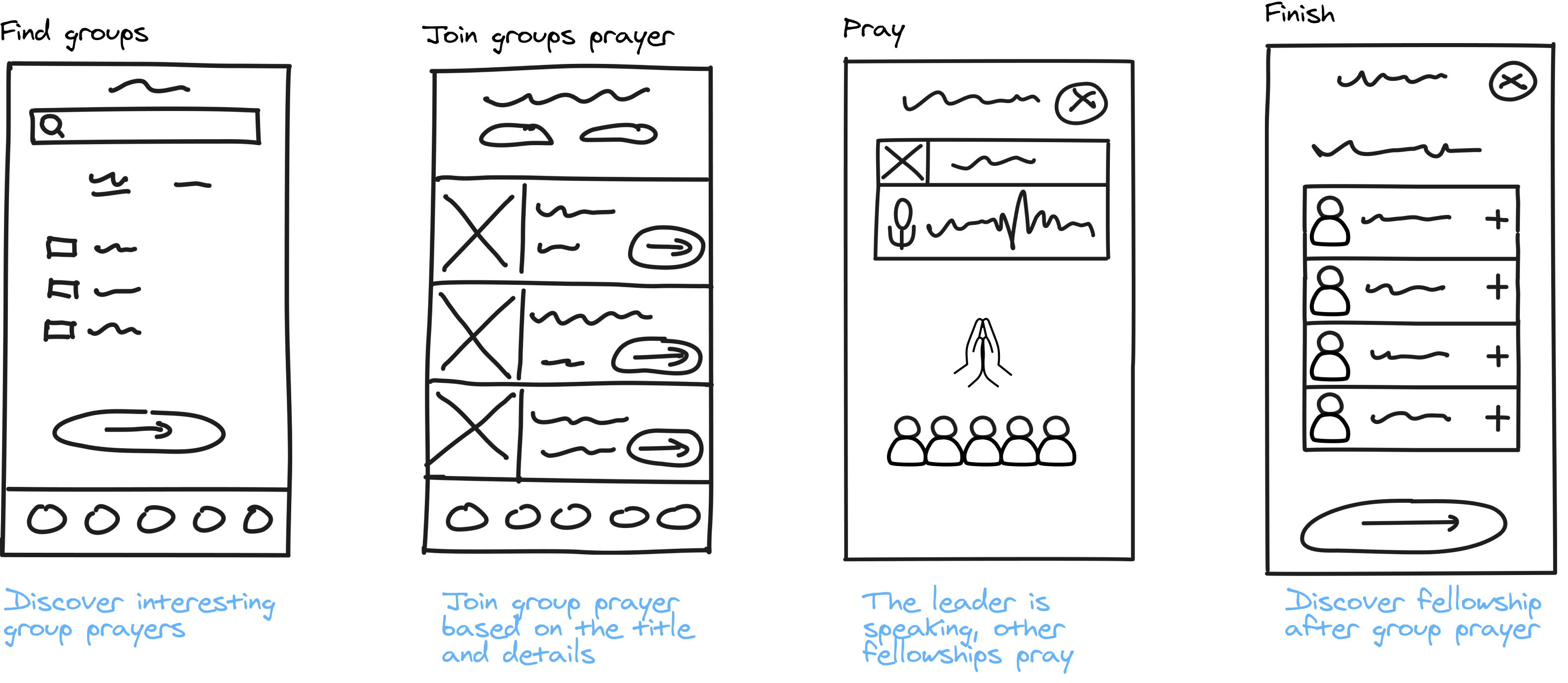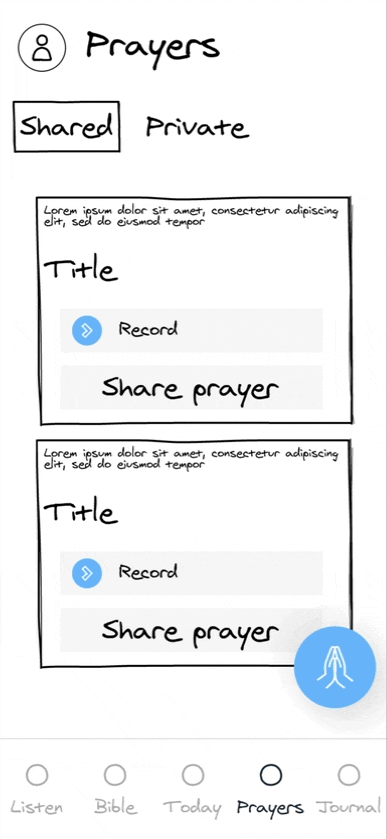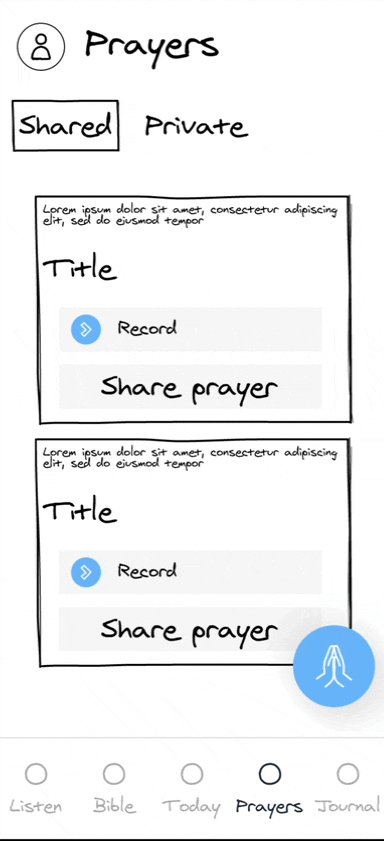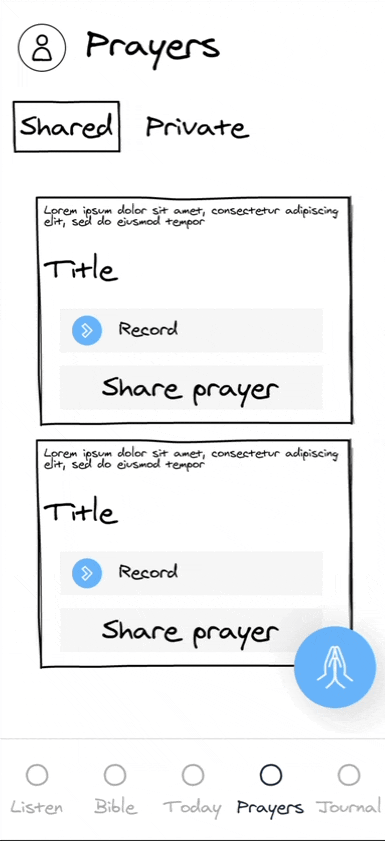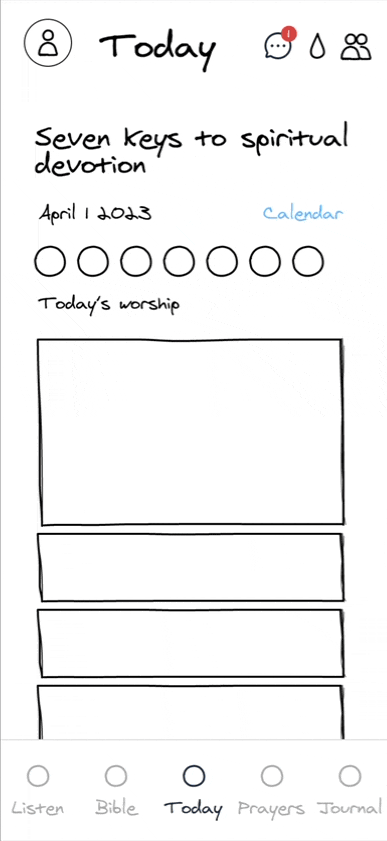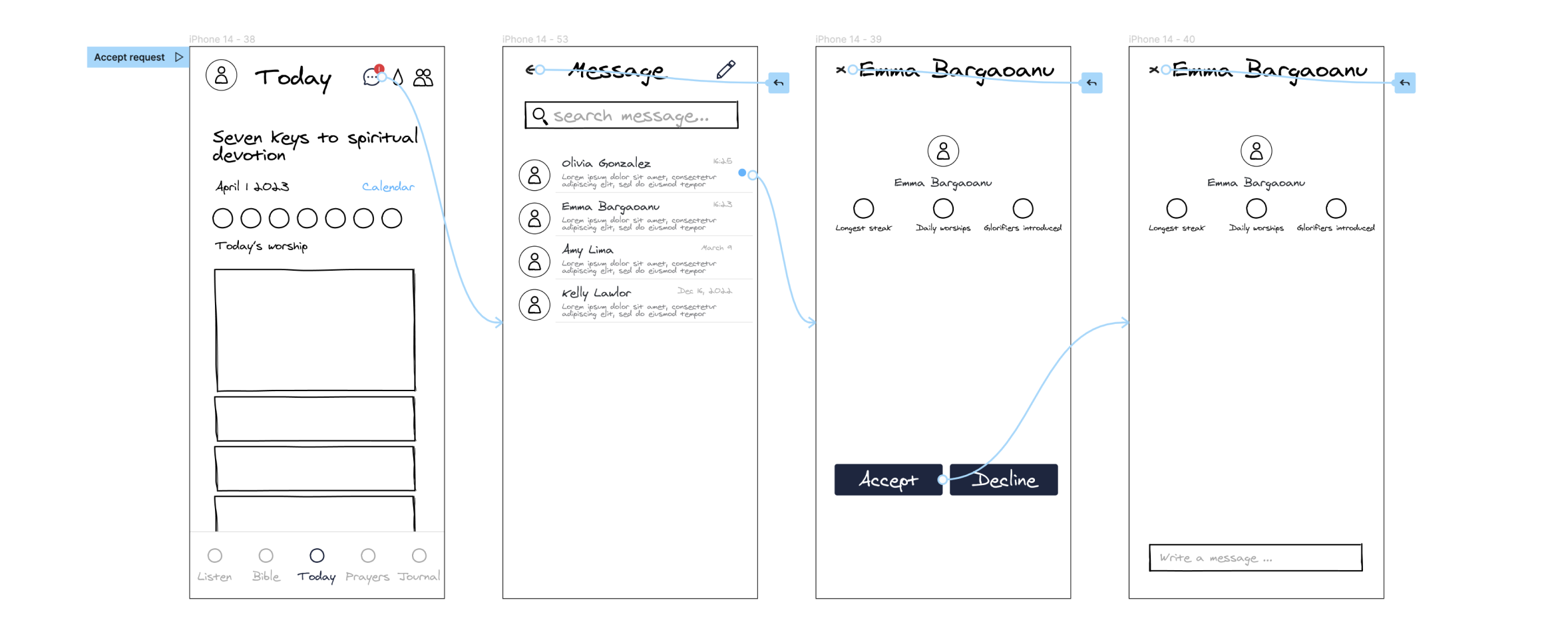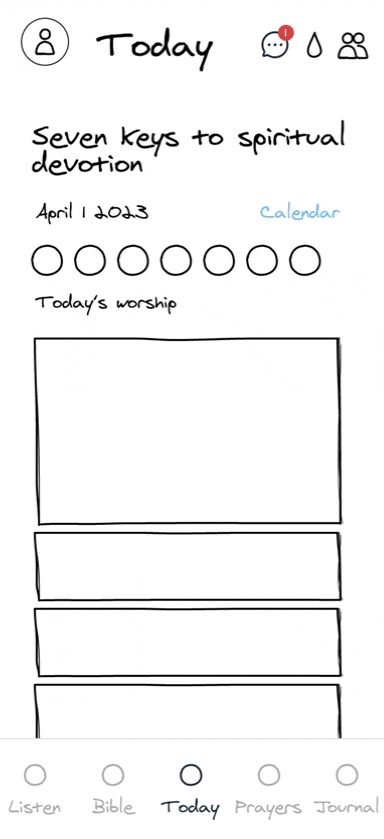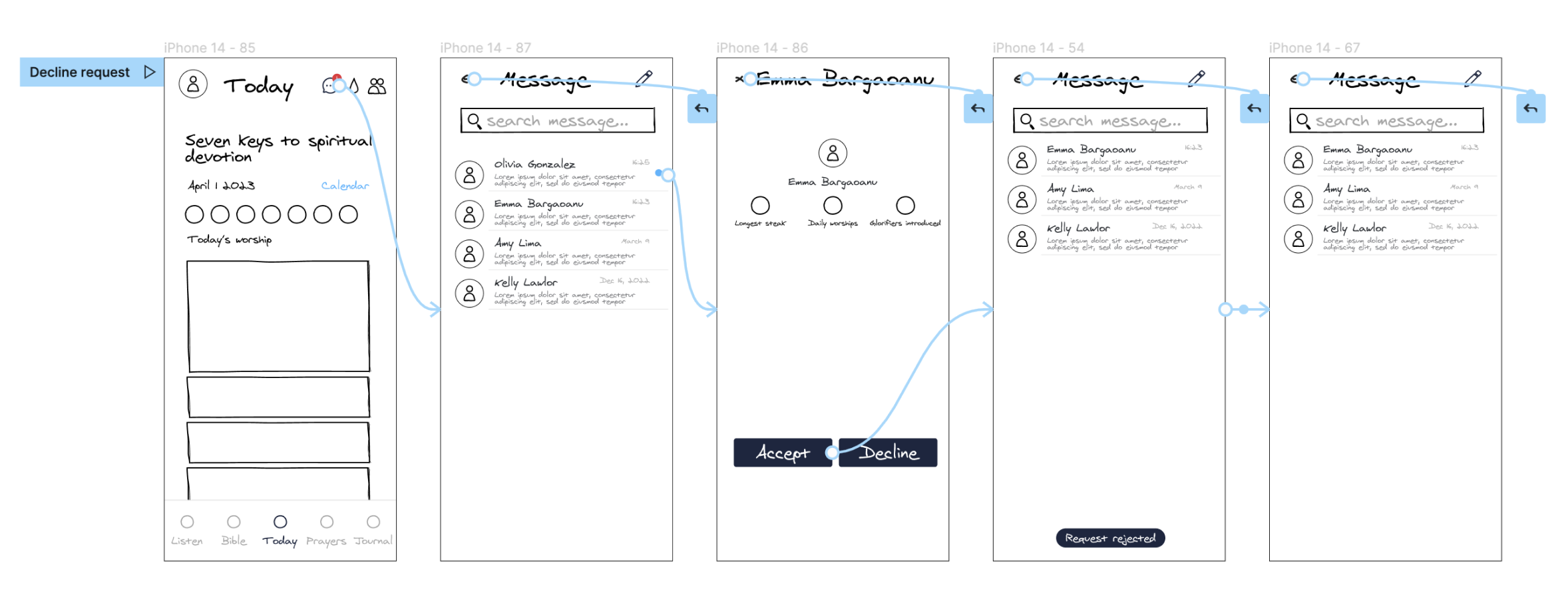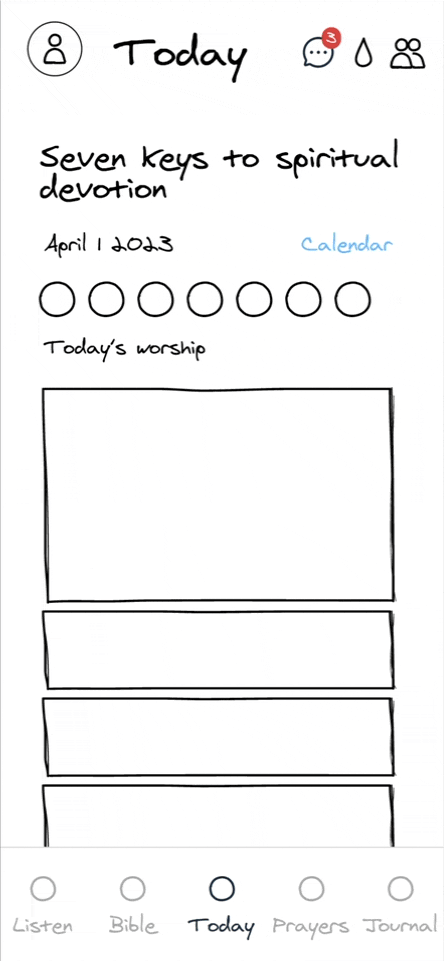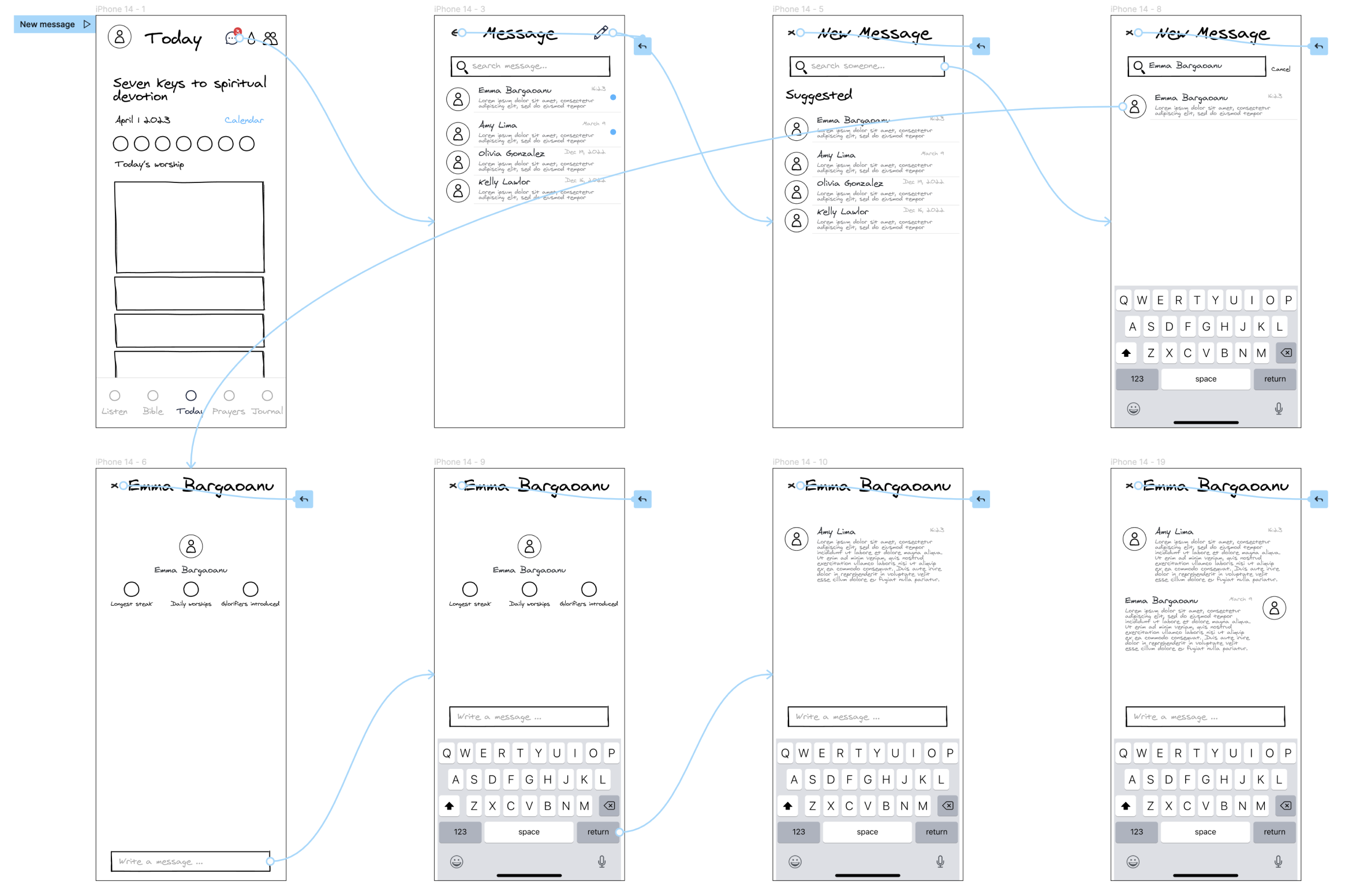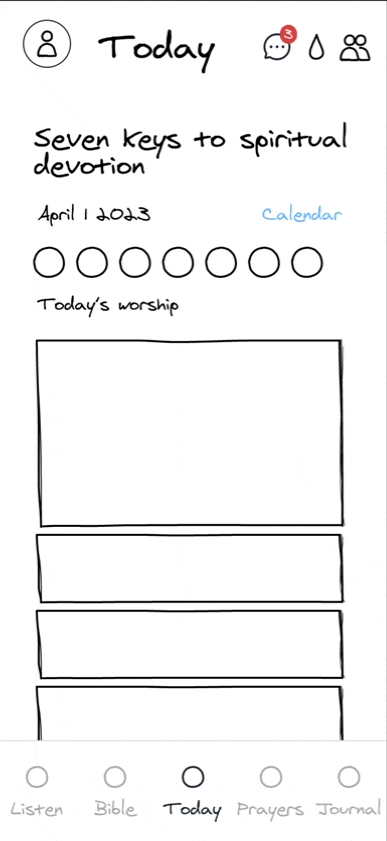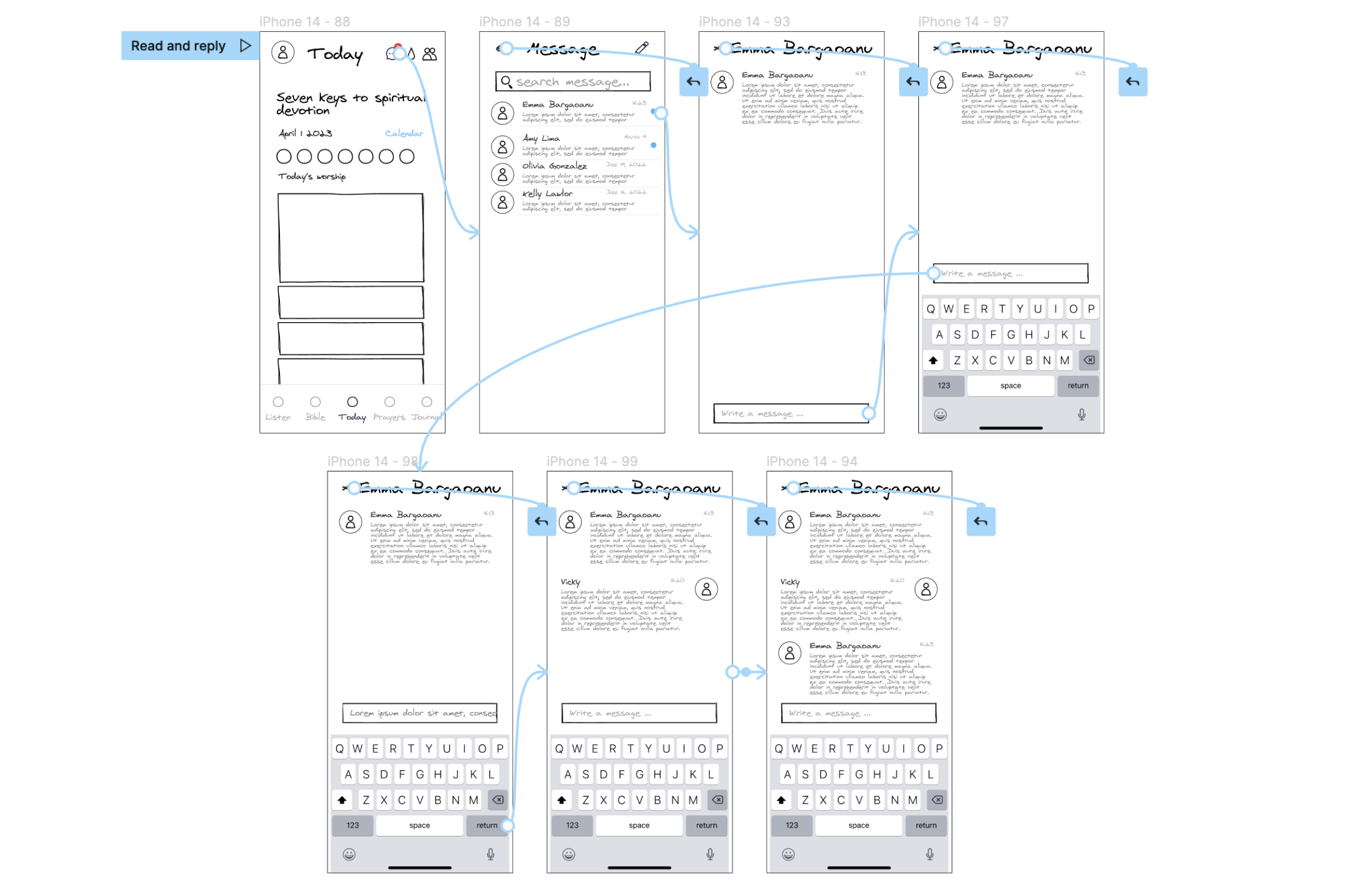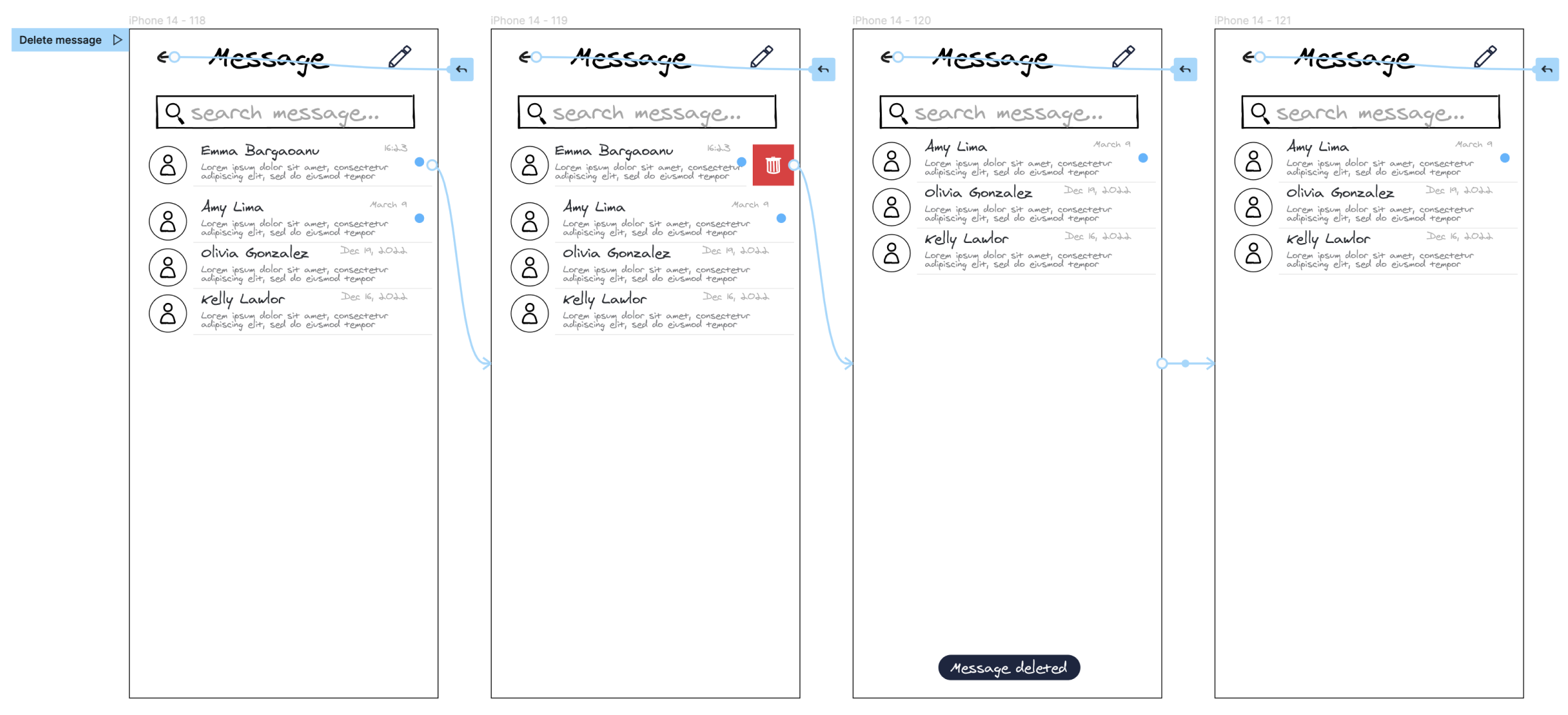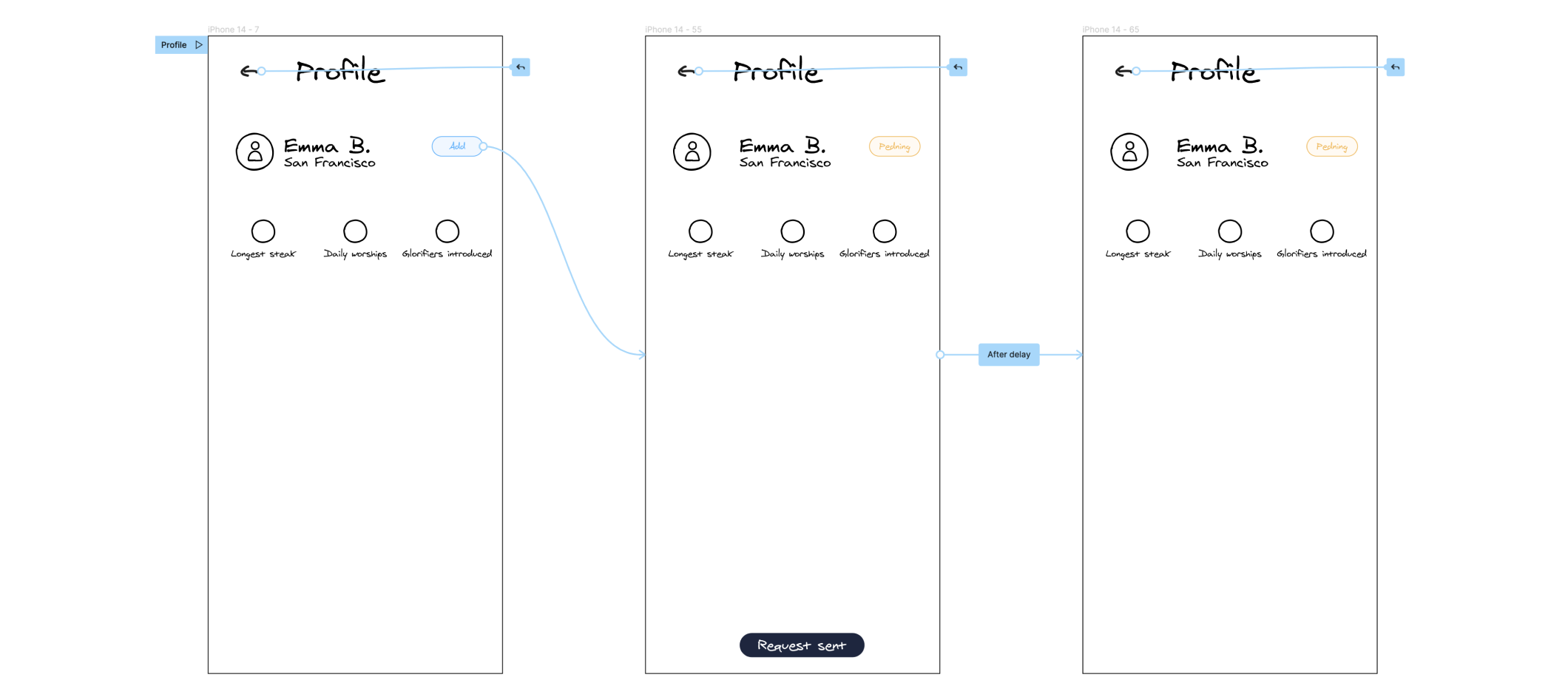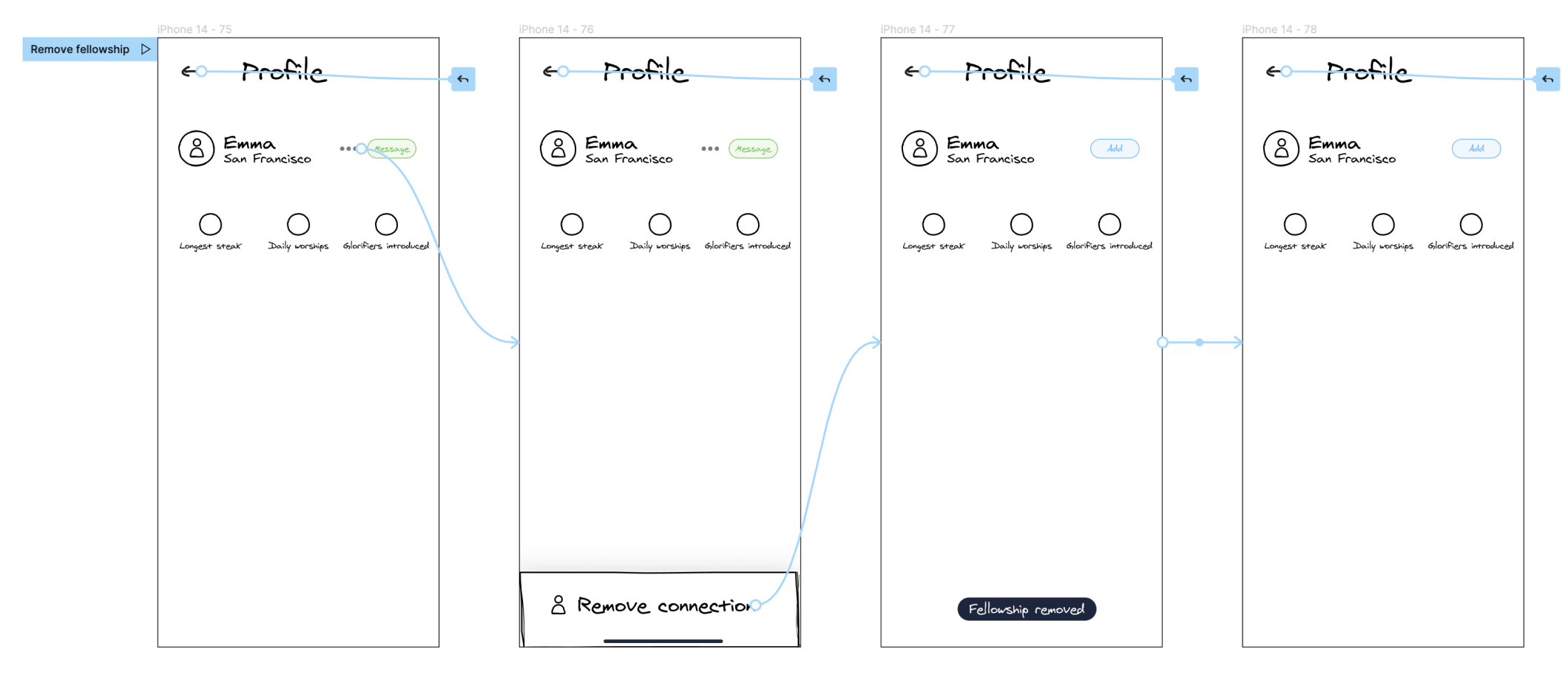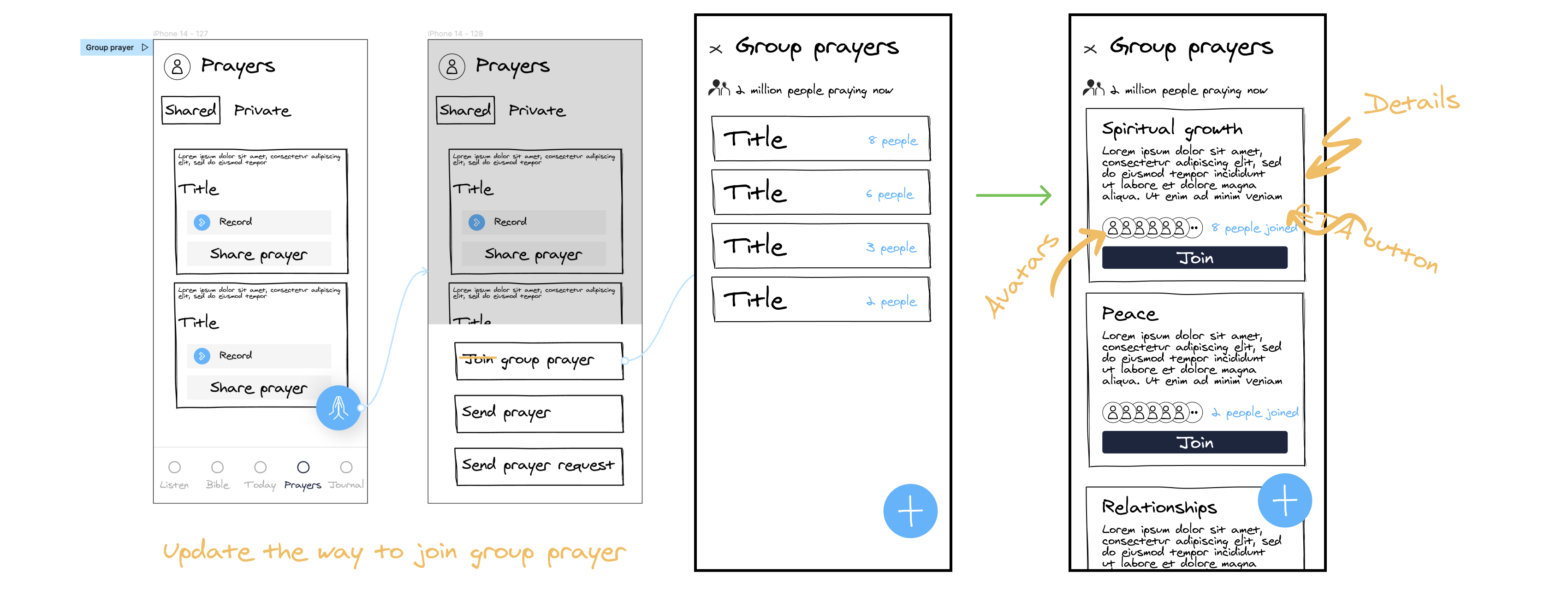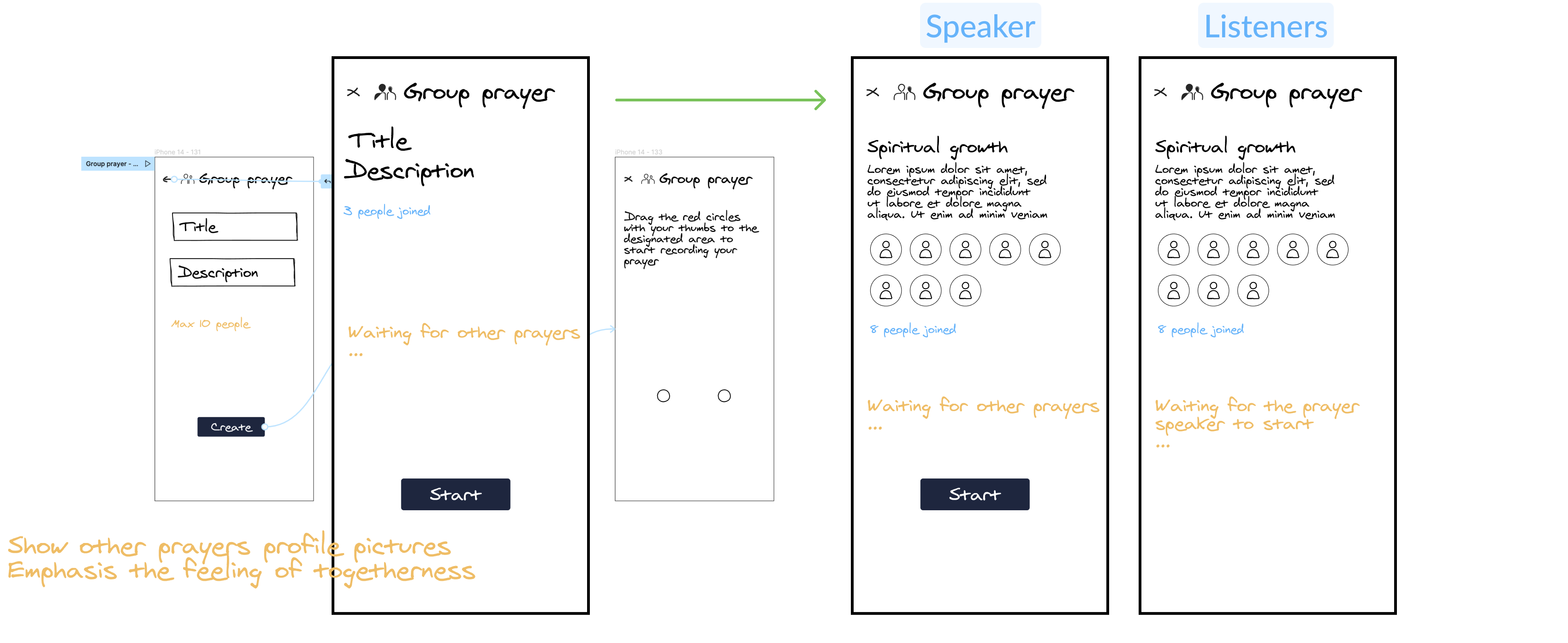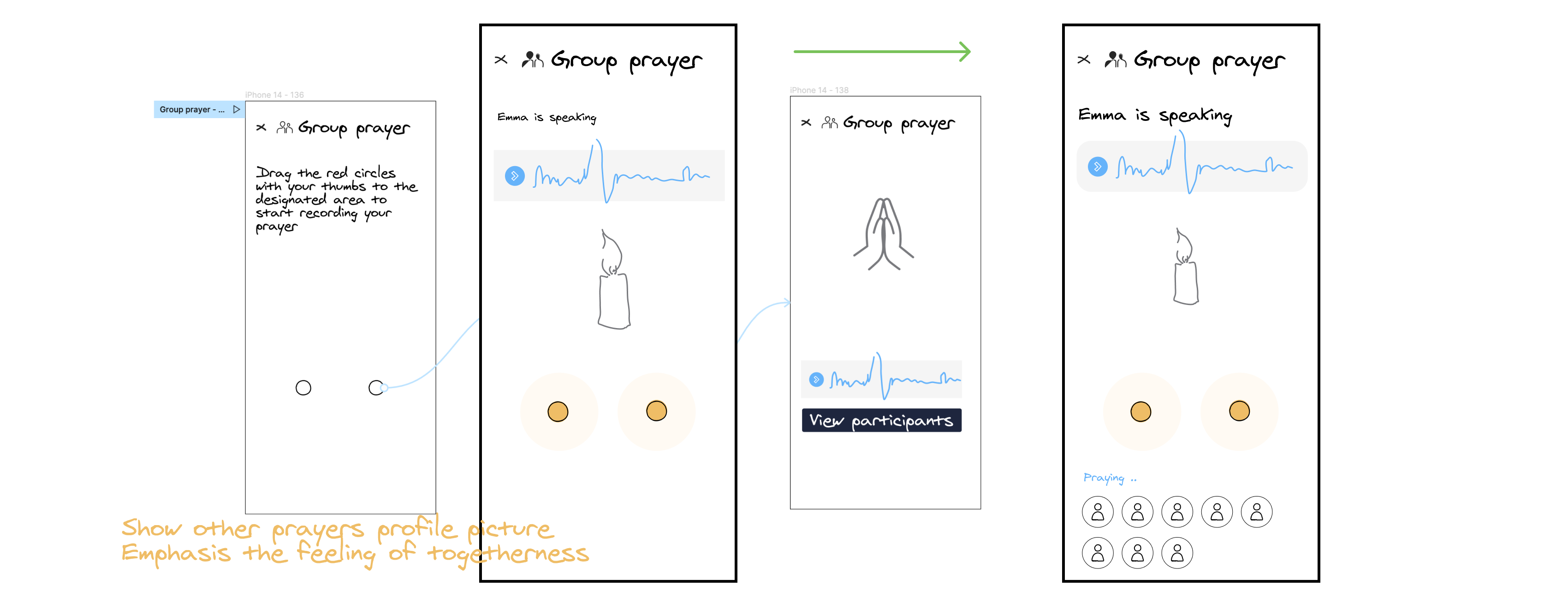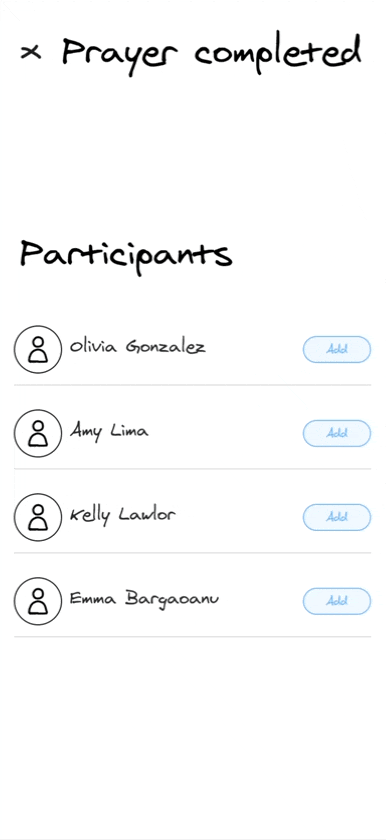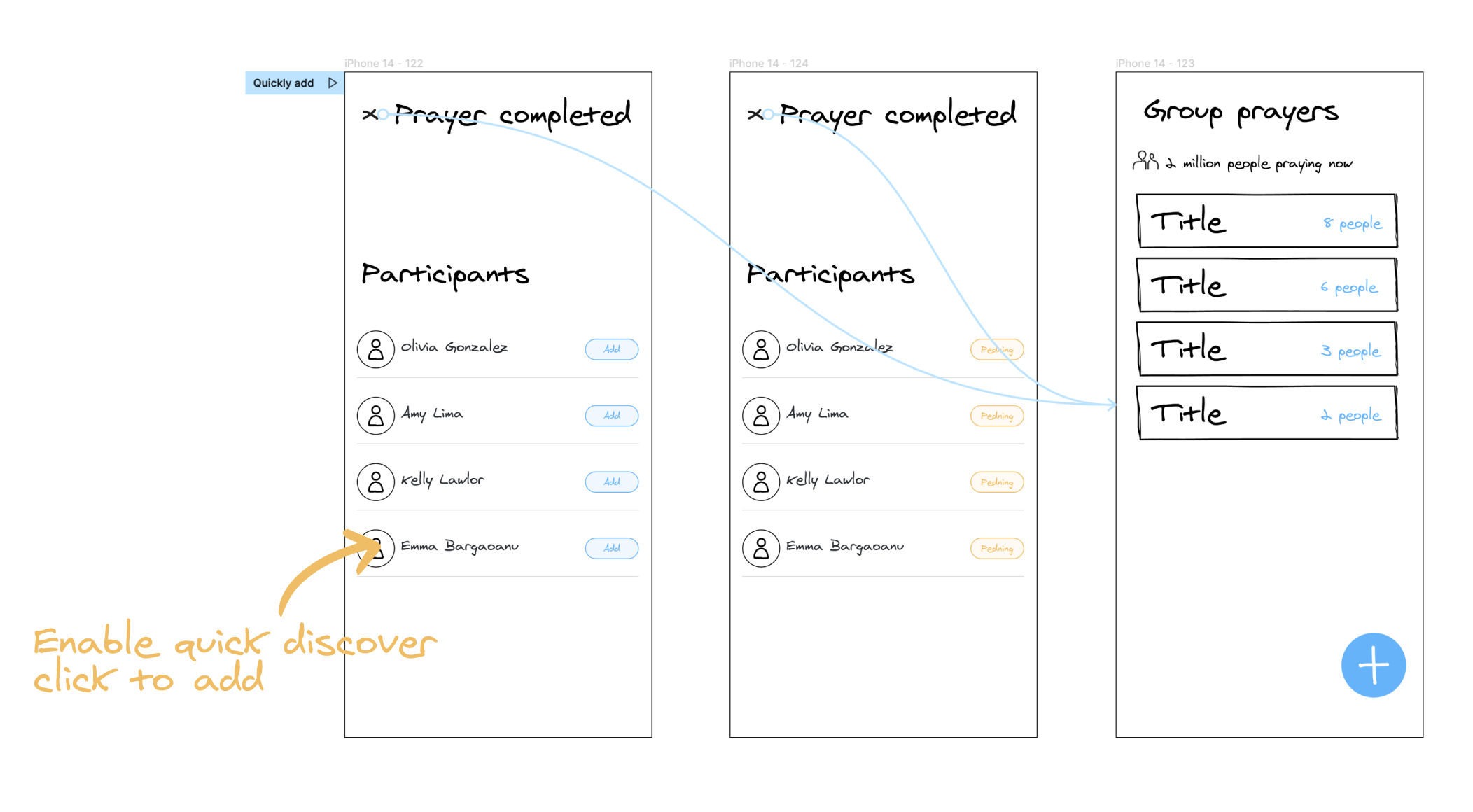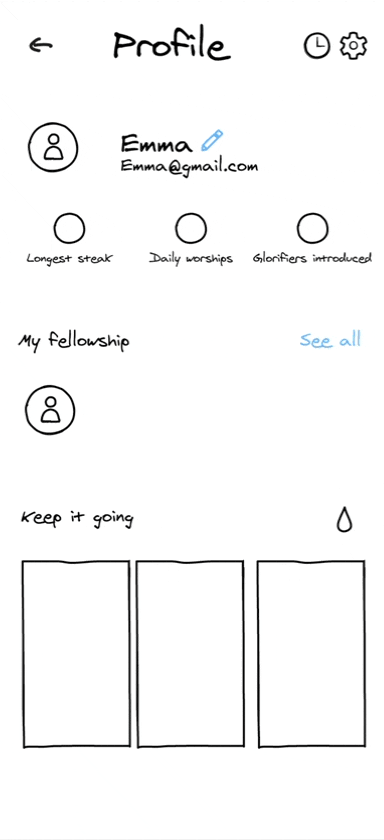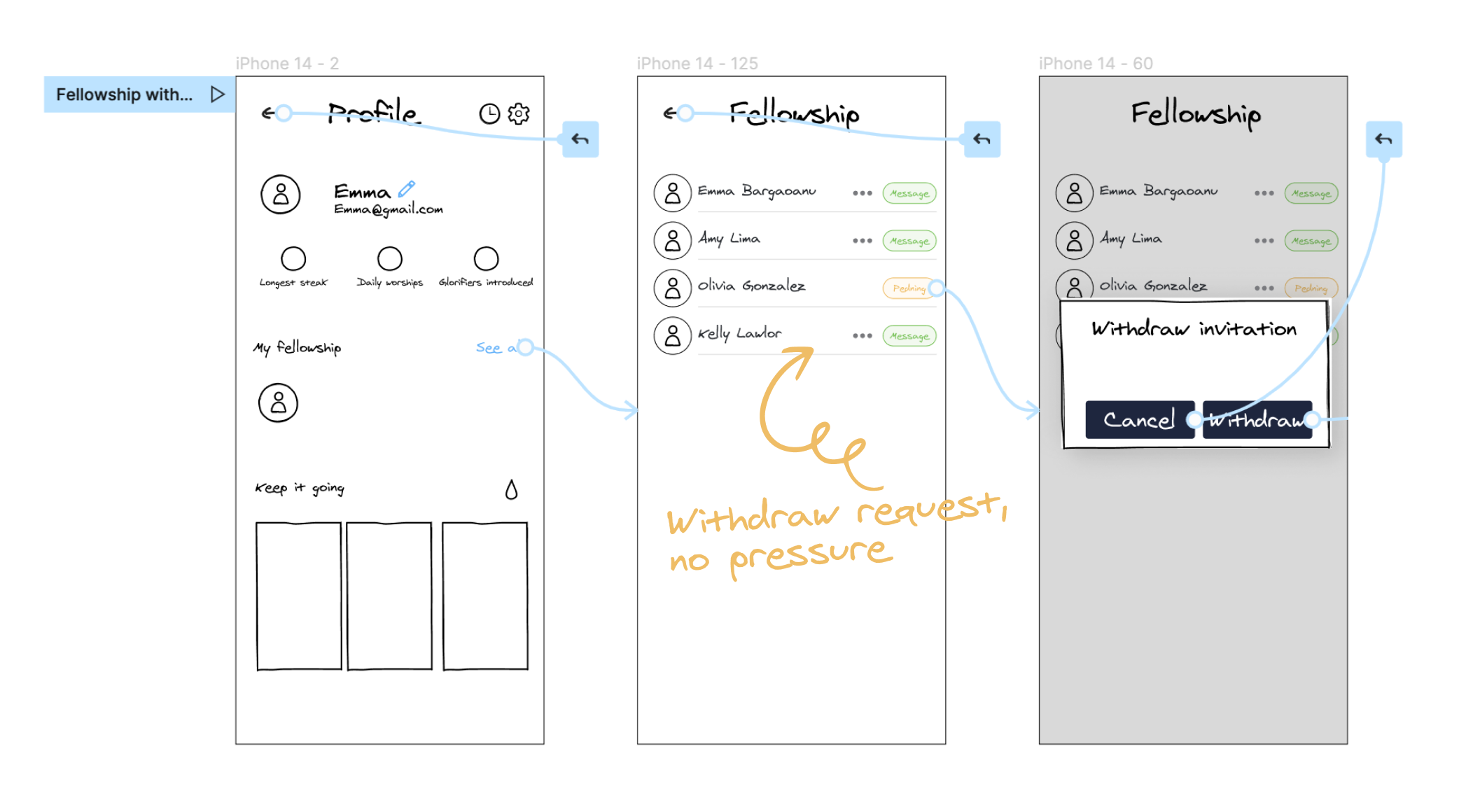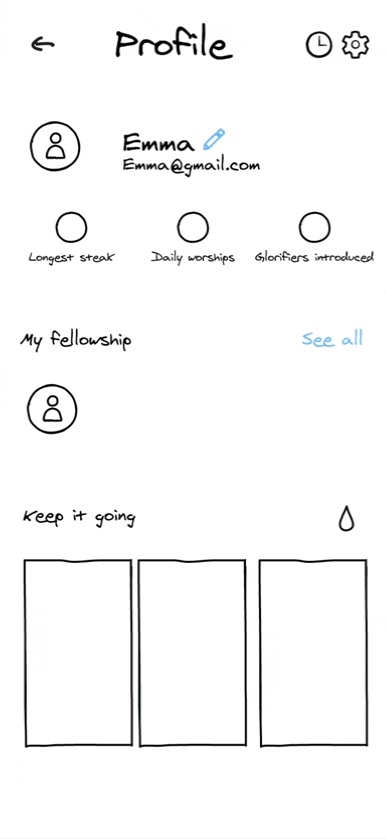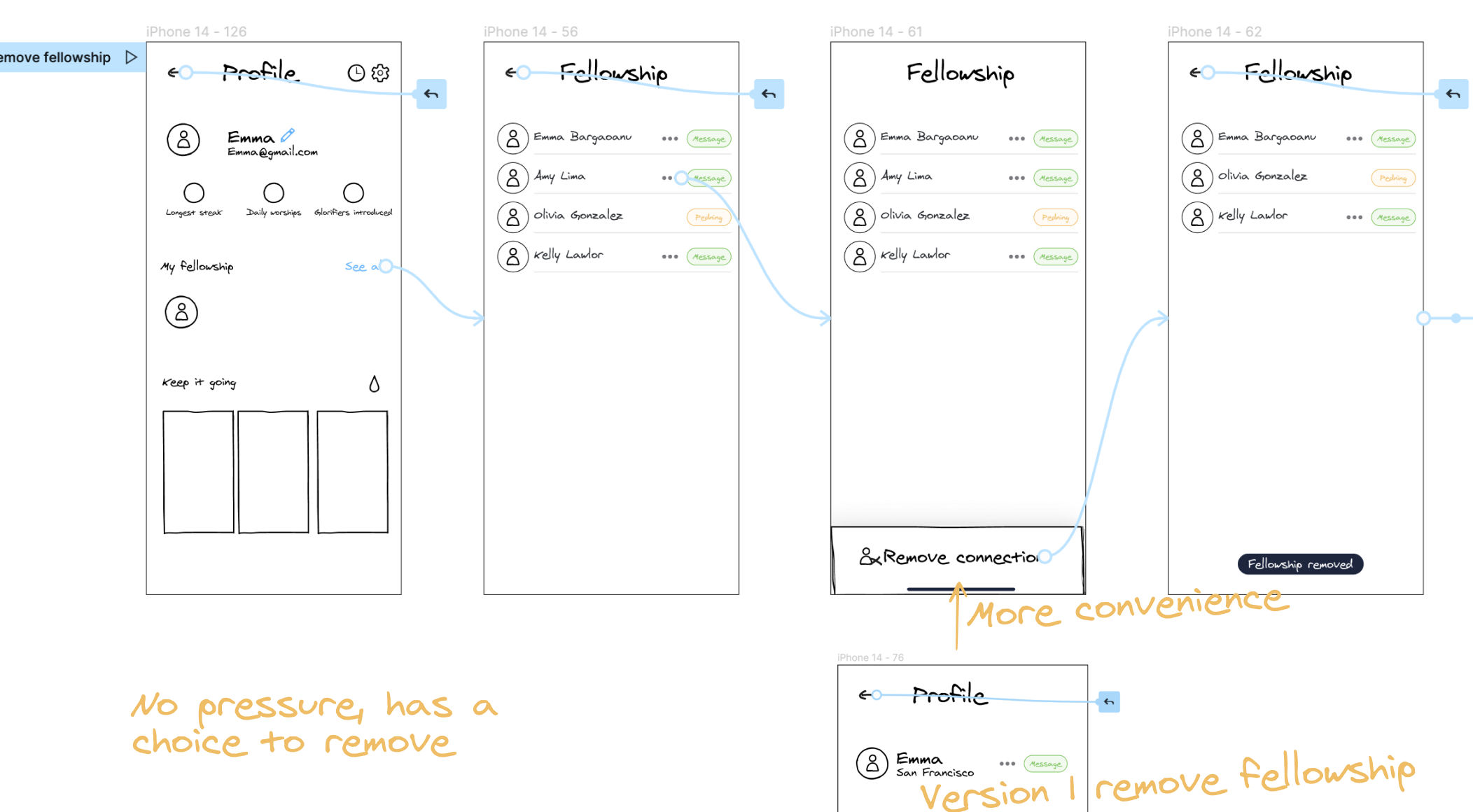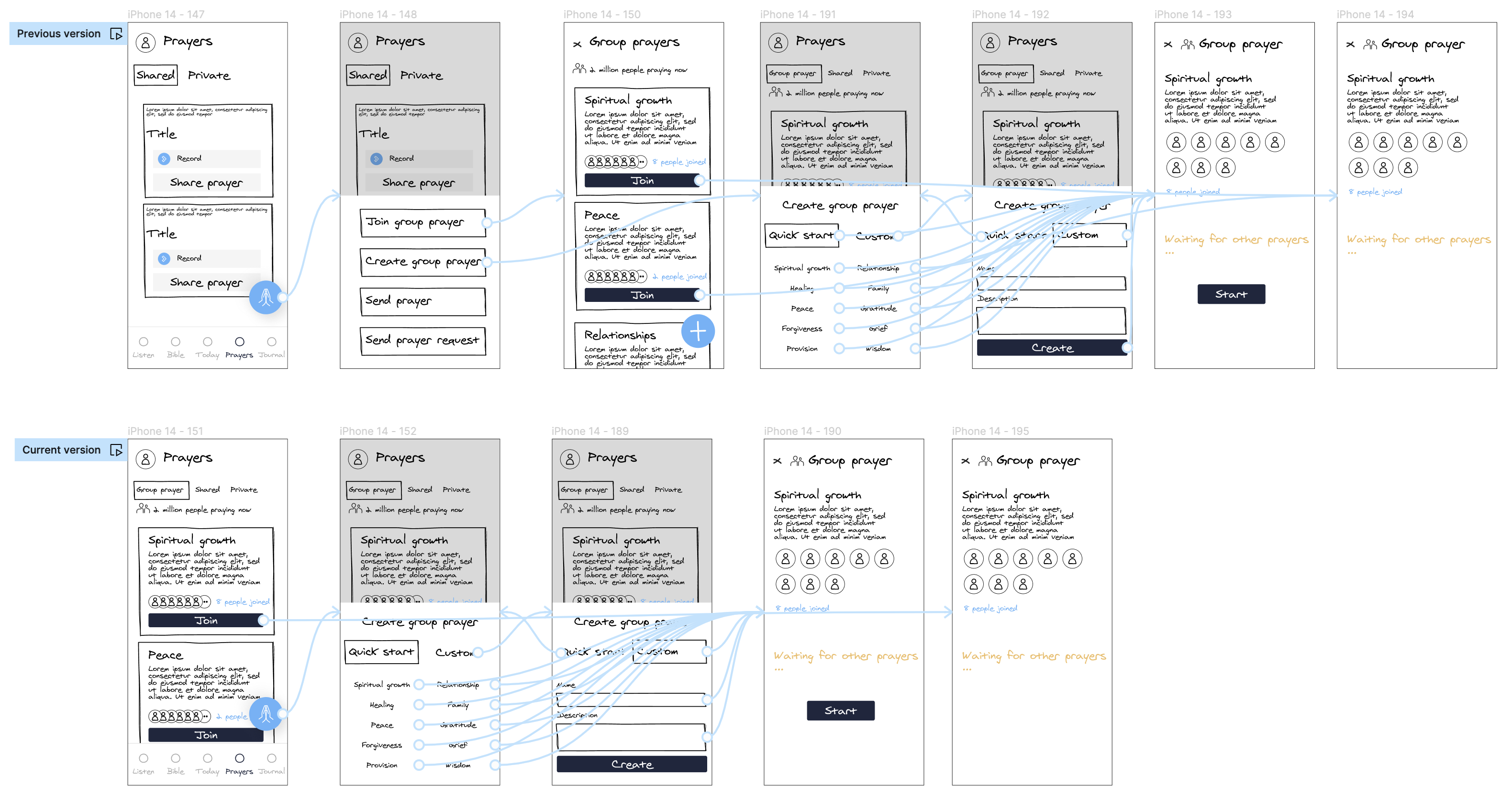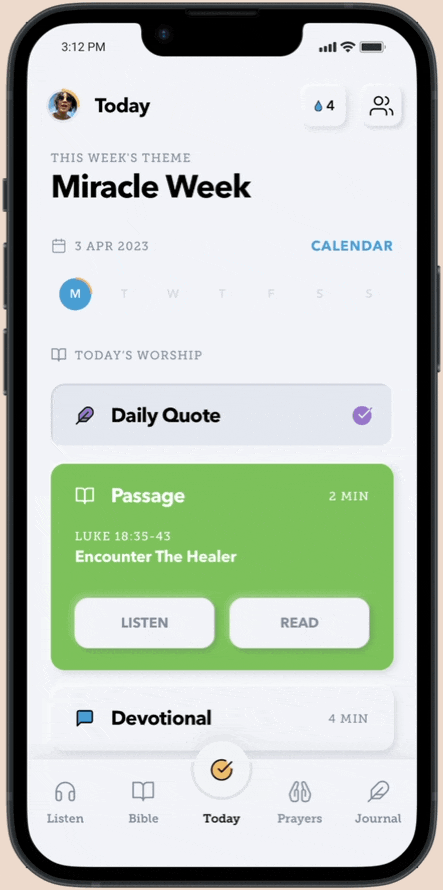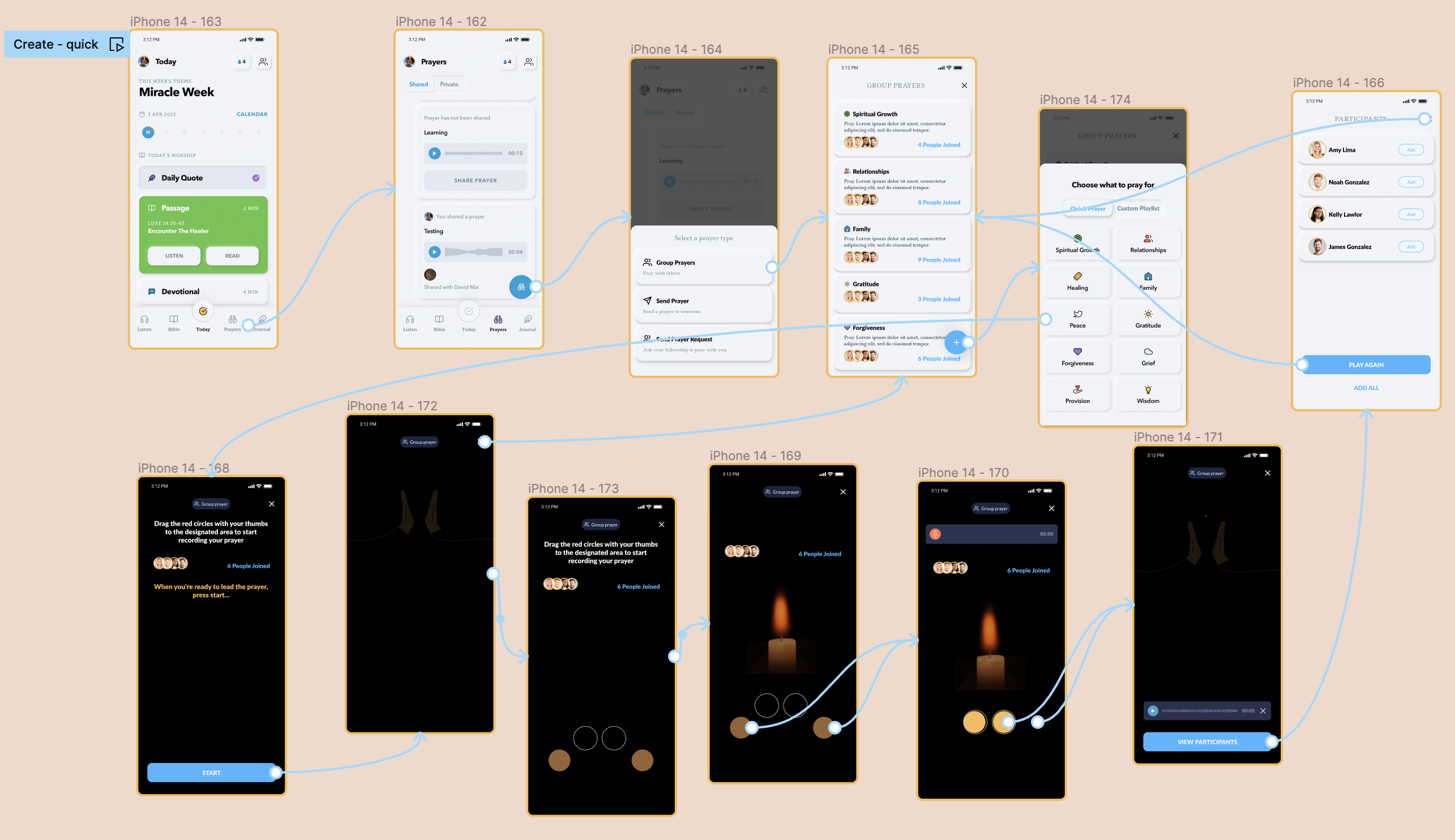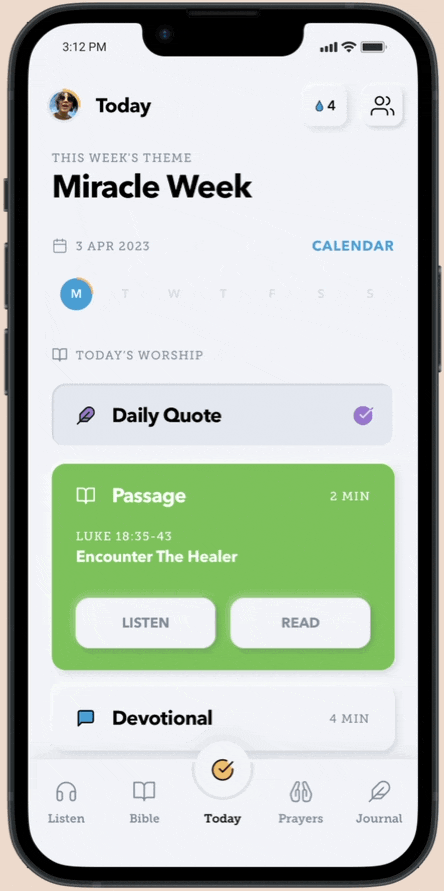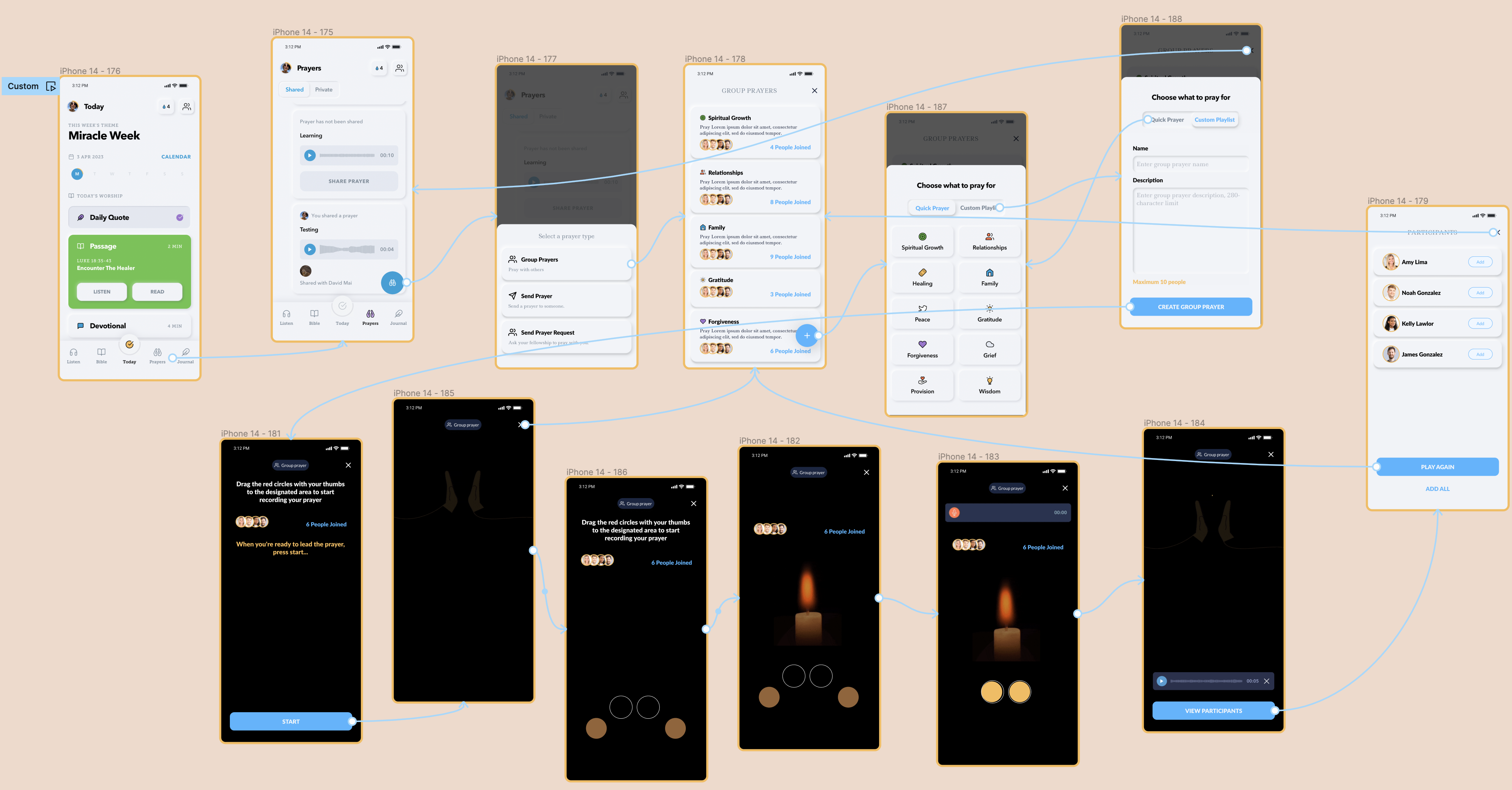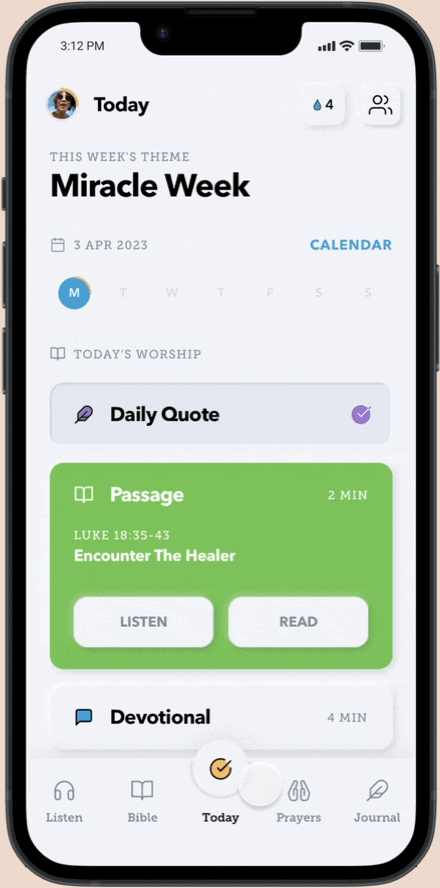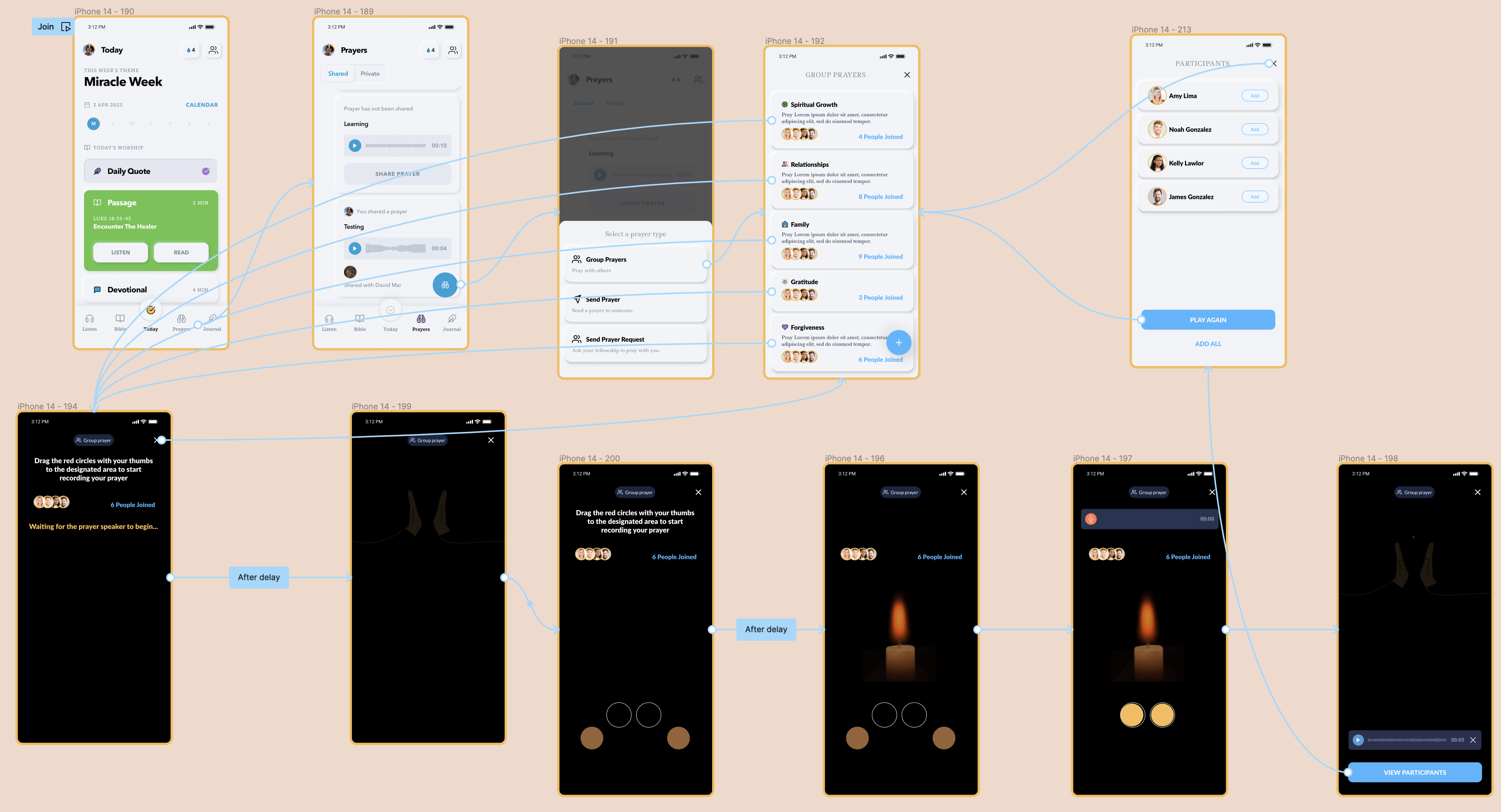Case study 
To address the current lack of social and community features, I am focused on enhancing the user experience by integrating community options.
The first step involves understanding why community holds a significant value within Christian practice. Following this, brainstorming and testing of potential solutions are carried out. An in-depth study of Glorify's existing app architecture will be conducted to seamlessly integrate the new community features. These additions will undergo design refinement through multiple rounds of testing and iteration.
Ultimately, the objective is to enrich the group worship experience, encouraging users to form meaningful connections.
Timeline 2023
Research
The goal is to create the first version of a Christian community on the Glorify platform to boost user engagement. Start by understanding the community: why people join, when they join, their activities, motivations, and goals. Use an affinity map to organize qualitative data from user interviews. Then brainstorm solutions and sketch key concepts for testing, aiming to understand user preferences.
Understand
Set Up Research
Context & problem statement
Context
Glorify primarily offers a single-player experience , where users can explore a vast library of content in a feature known as the Daily Worship. Renowned as the top Christian Daily Worship app.
Problem statement
Glorify exists in a primarily isolated experience. Community is integral to Christianity. There’s an opportunity to fully meet the user's needs for social and collaborative experiences in their faith journey.
Research plan
Background
The Glorify platform has mainly been utilized as a single-player experience, which has made it challenging for users to establish new connections. In order to address this issue, my aim is to leverage the platform's existing infrastructure and introduce activities that promote connections and cater to the initial version of its community.
Group worship constitutes a significant aspect of Christian community activities. While Glorify offers a vast library of content for individual daily worship, this research will specifically concentrate on the communal aspects of worship.
Research goal
Understand both the successful methods and pain points of having group worship
Research Method
Semi-structured user interview
Research questions
- How do Christians typically attend group worship? what they do? which group worship they like the most?
- Why Christians participate in group worship? How did they initiate? what is their motivation?
- What types of group worship have been most/least valuable to the participants in the past?
Participants
Christians/non-Christian seeking opportunities to connect and engage with fellow believers.
3 participants
- Participant 1 age. 38 male
- Participant 2 age. 46 female
- Participant 3 age. 27 female
Research goal ⇨ research questions ⇨ recruit participants
Discussion Guide | Interview Script
Introduction
Thank you very much for your time and participation in this interview. Do you have any final thoughts that you would like to share? Do you have any final questions?
Establish Rapport
Before we get started, I would love to get to know you a little bit more. What city do you live in? How long have you lived there? Who do you live with? Where do you currently work? What is your current role? Can you tell me a little bit more about your work?
Interview Question 1
What kind of group worship have you participated in as part of a Christian group worship?
Potential Follow-Up Prompts:
- Which one do you visit most frequently?
- Which one you like the most?
Interview Question 2
Why do you participate in group worship? How did you initiate? what is your motivation?
Potential Follow-Up Prompts:
- How did you initially become a part of group worship?
- What motivates you to join group worship?
Interview Question 3
What types of group worship experiences have been most valuable to you in the past? Why?
Potential Follow-Up Prompts:
- Have you encountered any difficulties in discovering new group worship?
- Have you had any negative experiences with group worship?
Conclusion
Thank you very much for your time and participation in this interview. Do you have any final thoughts that you would like to share? Do you have any final questions?
Click to open/close
Interview questions & answers
 James, 38 years old, Software
engineer, male, based
in SF Bay Area
James, 38 years old, Software
engineer, male, based
in SF Bay Area
Key Concern:
James places significant importance on contemplative and introspective worship experiences. He has a preference for quieter worship environments, valuing the depth and introspection it offers. Despite being actively involved in various group worship activities, he feels most connected and fulfilled in small group Bible studies. There's a challenge for him in finding more of these contemplative settings that align with his preferences.
What kind of group worship have you participated in as part of a Christian group worship?
I engage in daily group worship by participating in morning prayer gatherings, small group Bible studies, and occasional attend traditional liturgical worship services in a Protestant church..
You mentioned participating in morning prayer, small group Bible studies, and weekday worship services. I can imagine you already have had a lot of group worship experiences. Which one of these do you visit most frequently?
I most frequently visit small group Bible studies. I appreciate the in-depth discussions and the opportunity to connect with others on a deeper level in our shared exploration of the Bible. It is the setting where I find the most personal growth and fulfillment in my faith journey.
Why do you participate in group worship?
In a community of believers, we come together in group worship to experience a deep sense of connection and belonging. I find solace and strength in this collective gathering. The opportunity to worship alongside fellow believers uplifts my spirit and reminds me of the power of unity. Engaging in group worship allows me to express my gratitude and praise to God, sharing in the joy of His presence with others who walk the same path of faith.
How did you initially become a part of group worship?
I initially became a part of group worship through my involvement in the local church community. I may have started by attending church services or events, where I was welcomed and introduced to the idea of group worship. It could have been through an invitation from a friend or family member, or simply a personal decision to seek spiritual connection and community. Over time, as I experienced the power and beauty of group worship, I actively engaged and became a regular participant in the various gatherings and activities.
What types of group worship experiences have been most valuable to you in the past?
I have discovered the tremendous value of participating in contemplative worship experiences. These moments of reflective and introspective worship allow me to connect with God on a deeper level. Instead of the energetic and vibrant atmosphere of contemporary music, I find solace and spiritual nourishment in quiet spaces, where soft melodies and gentle instrumentation create an ambiance of tranquility. These worship experiences provide a sanctuary for introspection, prayer, and personal connection with God. Through this intentional stillness and reverence, I am able to engage my heart and mind, finding a profound sense of peace and closeness to the Divine.
Have you encountered any difficulties in discovering new group worship experiences or had any negative experiences with group worship?
I have encountered some difficulties in discovering new group worship experiences. It can be challenging to find contemplative and introspective worship settings that align with my preference for quieter worship environments. However, I have actively sought out communities and events that offer these types of worship experiences and have been able to find fulfillment in connecting with like-minded individuals.
Additional notes
- Prefers contemplative and introspective worship experiences.
- Values collective prayer and moments of intercession within a group.
 Sarah, 46 female, Scientist,
female, based in SF Bay Area
Sarah, 46 female, Scientist,
female, based in SF Bay Area
Key Concern:
Sarah cherishes a balanced blend of worship experiences, mixing traditional hymns with contemporary songs. She holds weekday worship services close to her heart, seeing them as a spiritual reset that maintains her faith focus throughout the week. Women's ministry events and retreats also resonate deeply with her, providing a nurturing environment. However, she has occasionally felt disconnected in some worship settings due to a lack of inclusivity or relevance to her life stage.
What kind of group worship have you participated in as part of a Christian group event?
I participate in daily group worship by engaging in devotionals and guided prayer sessions within small groups, attending women's ministry groups, weekday worship services, and being part of mentoring relationships.
You mentioned guided prayer sessions and weekday worship. I'm curious to know which one is your favorite group worship experience and the reasons behind your preference?
My favorite group worship is to attend weekday worship services. These gatherings provide a meaningful spiritual reset and help me maintain a consistent focus on my faith throughout the week. I find solace and inspiration in coming together with others to worship and learn from the teachings shared during these services.
Why do you participate in group worship?
Group worship is a sacred space where I feel a strong sense of community. The warmth and support of fellow believers provide me with encouragement and accountability. Through collective worship and prayer, I draw closer to God, feeling His presence as we lift our voices together. It is during these moments that I experience the power of shared faith, finding comfort and strength in knowing that I am not alone on my journey.
How did you initially become a part of group worship?
My journey into group worship began through an intentional search for spiritual nourishment and fellowship. It may have started with a desire to explore my faith more deeply or a specific event or program that caught my attention. I might have joined a women's ministry group, attended a weekday worship service, or connected with like-minded individuals in the community who encouraged me to be a part of group worship. The warm and welcoming environment, coupled with the sense of connection and support, made me feel at home and motivated me to continue participating in group worship.
What types of group worship experiences have been most valuable to you in the past?
I have discovered the immense value of a diverse worship experience. The blend of traditional hymns and contemporary worship songs strikes a beautiful balance, reaching into the depths of my faith. Participating in women's ministry events or retreats has provided a nurturing and empowering environment where I can connect with other women of faith.The collective worship, teaching, and fellowship in these gatherings have touched my heart and strengthened my spiritual journey.
Have you encountered any difficulties in discovering new group worship experiences or had any negative experiences with group worship?
I have not encountered significant difficulties in discovering new group worship experiences. I have found a variety of worship opportunities that align with my desire for a balanced blend of traditional hymns and contemporary worship songs. However, there have been instances where I felt disconnected from the worship environment due to a lack of inclusivity or relevance to my specific stage of life.
Additional notes
- Finds value in women's ministry events and retreats, fostering a nurturing and empowering environment.
- Seeks worship experiences that provide a sense of community and connection.
 Jennifer, 27 years old,
Designer, female, based in New York
Jennifer, 27 years old,
Designer, female, based in New York
Key Concern:
Jennifer embodies a youthful and dynamic approach to worship. She is most drawn to creative worship expressions like art, music, or dance, seeing them as a unique and personal means to connect with God. The vibrant energy and the opportunity to express herself creatively is vital for her. Even though she frequently visits young adult-focused small group studies, finding worship settings that cater to her dynamic and interactive style becomes challenging.
What kind of group worship have you participated in as part of a Christian group event?
I embrace vibrant and energetic daily group worship through contemporary music, engaging in small group studies and discussions, volunteering at food banks or community outreach programs, and expressing my faith through creative worship expressions like art, music, or dance.
Which of the group art, music, or dance worship experiences is your favorite, and which one do you attend most frequently?
while I visit small group studies and discussions tailored for young adults frequently, the one I like the most is engaging in creative worship expressions like art, music, or dance. This form of worship allows me to express my faith in a unique and personal way, and it resonates deeply with me as a way to connect with God and engage with my spirituality.
Why do you participate in group worship?
Group worship ignites a deep connection with my generation and empowers me to express my love for God. Engaging in dynamic and passionate worship experiences resonates with the fire within me. The community of like-minded individuals fuels my desire to live out my faith boldly. Through interactive discussions and teachings, I learn and grow, equipping myself to face the challenges of the world. The creativity and expressive nature of our worship allow me to celebrate God's goodness with fervor and authenticity.
How did you initially become a part of group worship?
My entry into group worship began with a desire to find a community of believers who shared my passion for vibrant and authentic worship. I may have sought out young adult ministries or events specifically tailored for my age group, where I discovered a sense of belonging and a space to express my faith in creative ways. The energy and enthusiasm of others drew me in, and I realized the power of coming together with peers who were on a similar journey of faith. From that point forward, I actively engaged in group worship, finding it to be a source of inspiration, connection, and growth.
What types of group worship experiences have been most valuable to you in the past?
I have found immense value in dynamic and interactive worship experiences that speak to my generation. Engaging with contemporary music, visual arts, and creative expressions of worship like art, dance, or spoken word allows me to connect with God on a deeply personal and expressive level. The energy and passion in these worship settings inspire me, while engaging in small group studies and discussions nurtures my thirst for knowledge and understanding. Through relevant teachings and dialogues, I find inspiration to live out my faith boldly in my daily life.
Have you encountered any difficulties in discovering new group worship experiences or had any negative experiences with group worship?
I have occasionally encountered challenges in discovering new group worship experiences that truly resonate with my generation. It can be difficult to find worship settings that incorporate the dynamic and interactive elements I seek, such as creative expressions and contemporary styles. However, I have actively sought out churches, events, or communities that cater to young adults and have been able to find fulfilling worship experiences that align with my preferences.
Additional notes
- Enjoys dynamic and interactive worship experiences.
- Values creative expressions of worship, such as art, music, or dance.
Synthesize user feedback with Affinity Mapping 
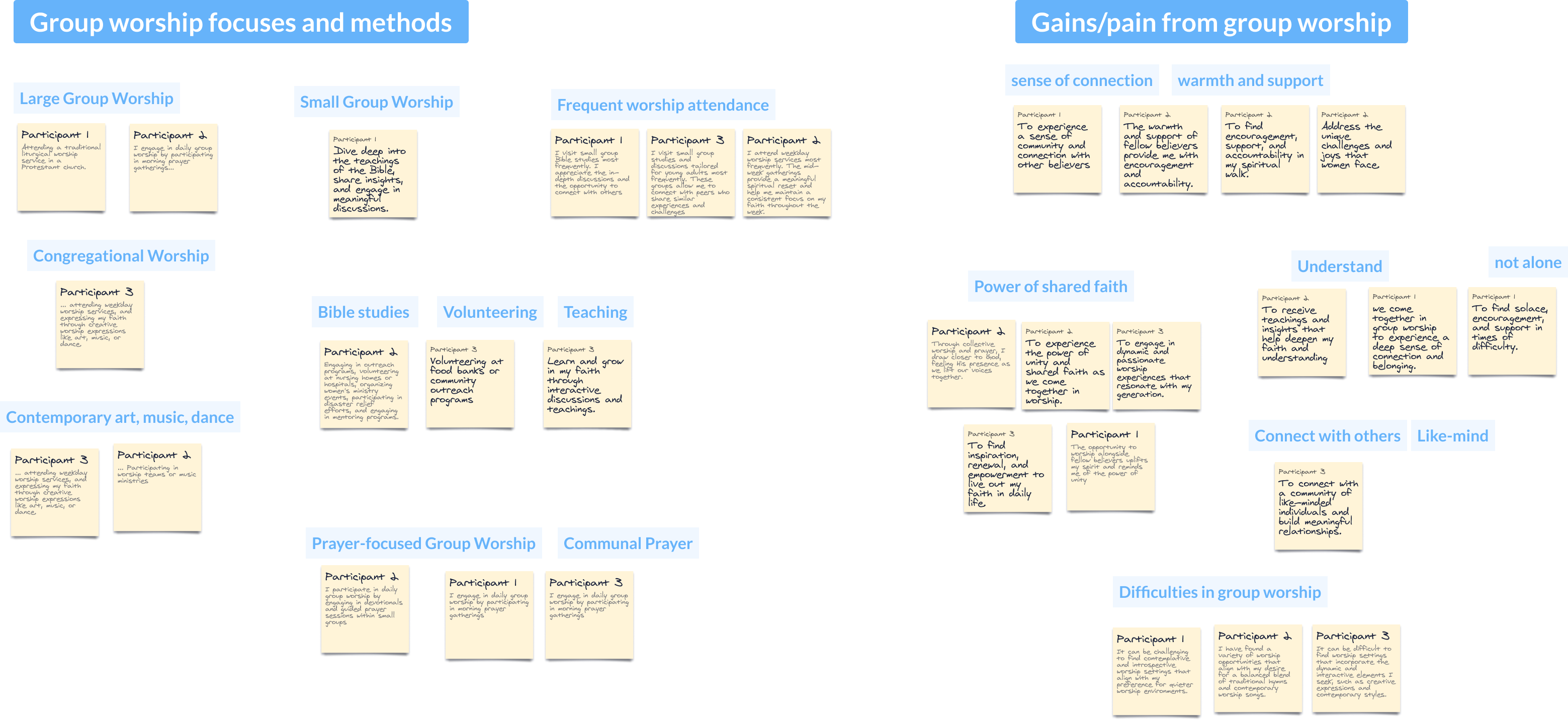
By clustering individual observations on a board, patterns emerge, allowing me to quickly identify themes and make informed decisions. It simplifies complex user data, facilitating a clearer understanding of user needs and preferences.
Findings
 Finding 1 - the motivation
Finding 1 - the motivation
The participants expressed a range of preferences when it comes to worship styles and expressions. The primary benefits that Christians derive from attending such worship include the strength derived from shared faith, mutual understanding, support, and the opportunity to connect with others.
"To find inspiration, renewal, and empowerment to live out my faith in daily life." - Jennifer (Participant 3)
"To experience a sense of community and connection with other believers." - James (Participant 1)
"To receive teachings and insights that help deepen my faith and understanding." - Sarah (Participant 2)
 Finding 2 - the purpose
Finding 2 - the purpose
Participants tend to attend small group events more frequently due to the enriching discussions and the chance to forge connections with fellow participants.
"I visit small group studies and discussions most frequently. These groups allow me to connect with peers who share similar experiences and challenges." - Jennifer (Participant 3)"
"I visit small group Bible studies most frequently. I appreciate the in-depth discussions and the opportunity to connect with others." - James (Participant 1)
 Finding 3 - the difference
Finding 3 - the difference
Older participants often gravitate towards contemplative and introspective worship, while younger participants tend to prefer dynamic and interactive worship experiences.
"I prefer dynamic and interactive worship experiences." - Jennifer (Participant 3)
"I would like to participate in contemplative and introspective worship." - James (Participant 1)
 Finding 4 - the challenge
Finding 4 - the challenge
Participants in group worship often face challenges, especially when it comes to navigating different interpretations of the worship style or environment.
"It can be difficult to find worship settings that incorporate the dynamic and interactive elements I seek, such as creative expressions and contemporary styles." -Jennifer (Participant 3)
"It can be challenging to find contemplative and introspective worship settings that align with my preference for quieter worship environments." -James (Participant 1)
Define
Define the problem
What? Who? Where? When? Why?
5W's
Answers
Explanation
What is the problem?
Glorify exists in a primarily isolated experience.
Participants express the desire to understand and share their faith with others, as well as to offer assistance or seek support from others
"To find inspiration, renewal, and empowerment to live out my faith in daily life." - Jennifer (Participant 3)
"To experience a sense of community and connection with other believers." - James (Participant 1)
Who is affected by the problem?
Celebrate individuals who are willing to engage in group worship with others
The research includes participants from age 27 - 46
Where does this problem occur?
The problem occurs when people want to discuss and understand, share faith with others in the community
The background states that this problem takes place in the current Glorify app
When does this problem occur?
When individuals seek to share their faith, deepen their understanding of faith, or provide/receive support.
Participants in group worship often face challenges.
"It can be challenging to find contemplative and introspective worship settings that align with my preference for quieter worship environments." -James (Participant 1)
Why does this problem occur?
Why is this problem important?
The problem occurs when individuals feel lonely, seek support or trying to understand faith.
There’s an opportunity to fully meet the user's needs for social and collaborative experiences in their faith journey.
Participants note that when it comes to navigating different interpretations of the worship style or environment.
"It can be difficult to find worship settings that incorporate the dynamic and interactive elements I seek, such as creative expressions and contemporary styles." -Jennifer (Participant 3)
Problem statement update
Problem statement V1
Glorify exists in a primarily isolated experience. Community is integral to Christianity. There’s an opportunity to fully meet the user's needs for social and collaborative experiences in their faith journey.
Problem statement V2
Glorify exists in a primarily isolated experience, while community is integral to Christianity. There is an opportunity to enhance the Glorify app to foster community engagement, enabling users to easily find like-minded worship groups, facilitate seamless interaction, and establish meaningful connections within the platform.
Brainstorming Solutions with a Mind Map 
Brainstorming Solutions with a Focus on: Easy to search for like-minded worship groups. Enhancing seamless interactions within the community. Building and nurturing meaningful connections.
Prioritization 
Four categories
Most rational
Befriend in the community
- Enhance user profile by incorporating detailed worship statistics
- Facilitate user connections and seamless communication within the app.
Enable users toshare their daily worship with other users.
- Share Bible study notes
- Allow users to share their journal with other users within the app
- Share the music they were listening to
Most delightful
Discover and join group events
- Facilitate Bible study together through the app
- Enable users to search for specific group events
Befriend in the community
- discover like-minded groups or fellowships
Darling
Discover and join group events
- Facilitate prayer-focused group worship through the app
- Provide personalized group event recommendations
Long shot
Create a local group community
- Enable fellowships to find other fellowships within a specific area
- Enable fellowships to find places or people to help those in need
- Empower fellowships to engage in volunteering or teaching activities
How-Now-Wow Matrix
Essential features for the community's inaugural version include improved user profiles, tools for connecting with others, and options for sharing Bible study notes. While these are fundamental, they might not be the most exhilarating aspects.
The idea of a local community is not feasible because it's challenging to establish and the current platform isn't designed as a locally-focused mobile app
Striking a balance between features that bring delight and are deeply cherished, I've decided to develop functionalities for Bible study group worship and prayer-focused group worship, especially since the app currently supports a single-player mode.
Group Worship Through the App:
Group worship within the app, group prayer and Bible study, emerges as a top design choice, highlighting user engagement and community growth.
 Deepened Community Interaction:
Deepened Community Interaction:
While the 'Most Rational' category establishes connections and the 'Most Delightful' enhances discovery, the 'Darling' idea of group worship delves deeper into facilitating spiritual communion among users. It's an experience that can bind the community closer than shared notes or music.
 Unique Offering::
Unique Offering::
While many apps might facilitate sharing of notes, music, or journals, a space designed specifically for group prayer/Bible study is a rarer commodity, giving our platform a distinct edge.
 Balanced Approach:
Balanced Approach:
Being from the 'Darling' category, it strikes a balance between innovation and feasibility. It's a feature that's both daring and realistic, allowing us to explore new territories without straying too far from known grounds.
 Future Scalability:
Future Scalability:
Once a robust system for group worship/Bible study is established, it can be further expanded or refined, integrating elements from other categories. For instance, shared worship statistics from the 'Most Rational' category can be integrated to provide insights into group prayer sessions.
While my decision stems from a small sample size, with more time, I'd gather broader feedback and use quantitative surveys for deeper insights. Yet, even with this limited data, the 'group worship through the app' emerges as a leading design choice.
Draft the ideas 
Outline the fundamental steps for the two concepts. One focuses on facilitating a Bible study session, and the other addresses the organization of a group prayer session.
Test & Iterate Idea
Concept Test
Concept test plan
Objective:
- Concept A: Facilitating a Bible Study Session
- Concept B: Facilitating a Group Prayer Session.
To understand which of the two concepts, Concept A or Concept B, provides a more intuitive and user-friendly experience, especially in relation to the set tasks.
I also want to evaluate which concept is more effective in promoting interactions and connections among participants.
Methodology - Moderated tests
Number of Participants: 3
Recruitment of Participants: Three individuals will be selected, ensuring a mix of those familiar and unfamiliar with Bible study and group prayer sessions.
Procedure:
- Introduction and briefing of participants about the goal of the testing.
- Participants will engage with each concept and perform the listed tasks.
- Participants will be encouraged to voice out their thoughts and experiences as they navigate through the tasks.
- Following the completion of tasks for both concepts, participants will answer a set of questions.
Tasks of concept A & B
Concept A - Facilitating a Bible Study Session
Tasks for Participants:
- Discover a group prayer that align with their interests
- Find a suitable group prayer to participate in
- Engage in prayer with other fellowships within the room
- Foster connections with other fellowships after the group prayer session
Concept B - Facilitating a Group Prayer Session
Tasks for Participants:
- Discover topics that align with their interests
- Find a Bible study session to join
- Engage in discussions with other fellowships within the room
- Foster connections with other fellowships after the Bible study session
Questions for Participants:
- Which concept did you find more intuitive and why?
- Which set of tasks felt more engaging?
- Was there any task that felt unnecessary or redundant in either of the concepts?
- Which concept made you feel more connected to other fellowships?
- How could we improve each concept for a better user experience?
- Which concept would you be more inclined to use regularly?
Concept Test Results 
Engagement Level:
 Concept A - Bible Study
Concept A - Bible Study
Participants Successful: 1/3



Common Feedback: The participant enjoyed the process of join a Bible study but felt that subsequent tasks required reading an excessive amount of text.
 Concept B - Group Prayer
Concept B - Group Prayer
Participants Successful: 2/3



Common Feedback: Those who preferred this concept felt that discussions within a prayer were more interactive and stimulating than merely engaging in Bible study. They appreciated the balance between individual discovery and group interaction.
Connection with Fellowships:
 Concept A - Bible Study
Concept A - Bible Study
Participants Successful: 2/3



Common Feedback: The participant who felt more connected mentioned that the Bible study discussion format setting fostered a deep sense of unity and community. However, others felt it lacked the interactive aspect that promotes bonding.
 Concept B - Group Prayer
Concept B - Group Prayer
Participants Successful: 3/3



Common Feedback: The participants felt that the group prayer was conducive to fostering connections as it prompted open interaction, sharing of insights, and active participation.
Confusion/Redundancy:
 Concept A - Bible Study
Concept A - Bible Study
Participants Successful: 1/3



Common Feedback : The participant who found redundancy felt that "discovering a Bible study" and "finding a suitable Bible study to participate in" were overlapping tasks and could be combined for clarity.
 Concept B - Group Prayer
Concept B - Group Prayer
Participants Successful: 1/3



Common Feedback: The participant who found redundancy felt that "discovering a group prayer" and "finding a suitable group prayer to participate in" were overlapping tasks and could be combined for clarity.
Preference for Real-life Usage:
 Concept A - Bible Study
Concept A - Bible Study
Participants Successful: 1/3



Common Feedback: The participant felt that Concept A provided a more meditative and reflective environment, which they personally preferred.
 Concept B - Group Prayer
Concept B - Group Prayer
Participants Successful: 2/3



Common Feedback: Those who preferred Concept B felt it catered to both individual spiritual growth (through topic discovery) and community bonding (through discussions). They mentioned that this dual benefit made it more appealing for real-life application.
Conclusion
With feedback from three participants, both concepts appear promising. While the "Facilitating a Group Prayer Session" had slightly higher overall feedback, there were still areas for improvement in both.
Given the limited number of participants, it would be advisable to gather feedback from a larger group for more comprehensive insights. However, these initial findings can guide early iterations of the features.
Iteration Ideas 
Iteration Ideas for Facilitating a Group Prayer Session
These are basic yet effective iterations for an initial version of the "Facilitating a Group Prayer Session" feature. Once launched, gathering user feedback will provide insights into further refinements and additions.
Basic Features:
 Chat
Chat
Send: Design an intuitive message input area with a clear 'send' button for ease of use.
Receive: Ensure messages are displayed in a clear and readable format. Incoming messages should be differentiated from the user's messages, perhaps through color or positioning.
Reply: Implement a direct reply feature allowing users to respond to specific messages, ensuring that conversations remain organized.
 Fellowship
Fellowship
Add: Simplify the process of adding members to the fellowship group, potentially through a search bar and an 'add' button next to user names.
Accept: Send clear notifications to users when they receive fellowship requests. Allow them to easily accept or decline from the notification.
Remove: Offer group admins the option to remove a participant if necessary, but ensure that the process requires confirmation to avoid accidental removals.
The Group Prayer Session:
 Create
Create
Create: Design a clear and simple process for creating a group prayer session. This could be a straightforward form asking for session name, description, and maximum participants.
 Participation
Participation
Join: Streamline joining with a clear 'Join' button on the session page. Consider offering a brief overview of the session when a user hovers over or clicks the session name before joining.
Engage: Ensure stability in the chat and fellowship features so participants can engage smoothly throughout the session.
 Leave
Leave
Leave: Make leaving the session uncomplicated with a clear 'Leave' or 'Exit' button. Upon pressing, perhaps prompt the user with a confirmation to avoid unintentional exits.
Design
Based on concept testing, the group prayer option received positive feedback for encouraging open interaction, insight-sharing, and active participation. It's also easy to engage with and low-pressure.
To integrate this first version of the community feature into the existing Glorify system, start with card sorting and sitemap creation. Then, develop wireframes for testing, aiming to streamline all workflows to prevent issues later on.
Synthesis
Enablers 
Moderated Closed Card Sorting 
Sitemap
Sitemap update 
Proposed Additions 
 Group prayer
Group prayer
Enhancing the existing prayer feature to support group prayers.
- Enable create group prayer
- Enable participate group prayer
- Enable leave group prayer
 Chat
Chat
Adding a chat icon to the top navigation
- Able to see the notification
- Capable of receiving messages and fellowship requests from other fellowships.
- Enable the "Compose Message" feature for communication with other fellowships.
 Fellowship
Fellowship
Upgrading the current fellowship profile to facilitate fellowship connections.
- Adding a new "add/remove" icon to the existing fellowship page
- Adding a new "message" icon to the each fellowship
Wireframes
Group Prayer 
Hover to pause or navigate through the slideshow
Chat 
Profile 
Wireframe Test 1
Test plan 
Objective & Methodology
Objective:
Validate the integration of new features (Group Prayer, Chat, and Connect Fellowship) into the existing system, ensuring they are intuitive and user-friendly.
Methodology - Moderated tests:
Peer Evaluation: Engage a small group of friends to interact with the clickable wireframes in Figma.
Preparation & Procedure
Preparation:
- Recruitment of Participants: Select 3 participants, aiming for a mix of those familiar with the current system and potential new users.
- Environment: Use a quiet room with minimal distractions. If conducted virtually, ensure participants have a stable internet connection.
- Tools: Share the Figma wireframe link with participants, ensuring they have viewing and interacting access.
Test Procedure:
- Task Distribution: Assign tasks related to the new features.
- Observation: Monitor how participants navigate, noting any hesitations or areas of confusion.
- Feedback Collection: After tasks completion, gather feedback through a short questionnaire.
Scenarios & tasks
Tasks for Participants:
Group Prayer Flow
Task: Create a group prayer
Scenario: You've recently come across a topic that you feel deeply about and want others to join you in prayer. You decide to initiate a group prayer session about this.
Task: Locate and join an existing group prayer
Scenario: You've had a challenging week and are looking for spiritual support. You wish to join a group prayer session that resonates with your feelings.
Task: Exit or leave a group prayer
Scenario: You joined a group prayer session but realized it's not quite what you were looking for. You decide to leave and explore other sessions
Chat Flow
Task: Identify and accept a chat request
Scenario: After a prayer session, someone from the group sends you a chat request, possibly to discuss something you shared during the prayer. You decide to accept and see what they have to say
Task: Decline a chat request
Scenario: After reflecting on a recent group prayer session, you've thought of something you want to share with one of the members. You decide to send them a messages
Task: Compose and send a new message
Scenario: After reflecting on a recent group prayer session, you've thought of something you want to share with one of the members. You decide to send them a message.
Task: Open, read, and reply to an incoming message
Scenario: You notice a new message notification. Curious, you open it, read through, and decide to reply.
Task: Delete a chat message or conversation
Scenario: You've had a chat that you feel is better kept private or deleted. You decide to remove the chat history.
Connect Fellowship Flow
Task: Use the icon beside the profile to add a fellowship
Scenario: During a group prayer session, you came across someone whose insights and perspectives resonated deeply with you. You decide you'd like to connect with them more often and choose to add them to your fellowship.
Task: Remove or disconnect from a fellowship
Scenario: Over time, you've realized that you share fewer common interests with a member of your fellowship. You decide it's best to disconnect and make space for new connections.
Testing Results 
Group Prayer Flow
 Create a group prayer
Create a group prayer
Successful Rate: 3/3



Error Rate: 1/3



Average Time on Task : 58 seconds
Satisfaction Rating: 4.3/5
Feedback: Create group prayer navigation is not very straightforward; users have to go through 2 modals/pop-ups.
 Locate and join a group prayer
Locate and join a group prayer
Successful Rate: 2/3



Error Rate: 1/3



Average Time on Task : 46 seconds
Satisfaction Rating: 3.7/5
Feedback: Two participants mentioned they’d like clearer prompts on what details to include for the prayer topic. 1 participants desired a filtering option to narrow down choices
 Exit or leave a group prayer
Exit or leave a group prayer
Successful Rate: 3/3



Error Rate: 0/3



Average Time on Task : 3 seconds
Satisfaction Rating: 5/5
Feedback: No major issues.
Chat Flow
 Identify and accept a request
Identify and accept a request
Successful Rate: 2/3



Error Rate: 1/3



Average Time on Task : 34 seconds
Satisfaction Rating: 4.3/5
Feedback: Two participants wanted an indicator for unread messages.
 Decline a chat request
Decline a chat request
Successful Rate: 3/3



Error Rate: 0/3



Average Time on Task : 6 seconds
Satisfaction Rating: 5/5
Feedback: No major issues.
 Compose and send a new message:
Compose and send a new message:
Successful Rate: 3/3



Error Rate: 0/3



Average Time on Task : 38 seconds
Satisfaction Rating: 4.8/5
Feedback: Participants felt the chat interface was intuitive
Connect Fellowship Flow
 Use the icon beside the profile to add a fellowship
Use the icon beside the profile to add a fellowship
Successful Rate: 3/3



Error Rate: 1/3



Average Time on Task : 6 seconds
Satisfaction Rating: 5/5
Feedback: 1 participant found the icon a little small
 Remove or disconnect from a fellowship
Remove or disconnect from a fellowship
Successful Rate: 3/3



Error Rate: 0/3



Average Time on Task : 13 seconds
Satisfaction Rating: 4.8/5
Feedback: One participant suggested adding a reason or feedback option for disconnection
Confusion and Recommendations 
 Points of Confusion
Points of Confusion
- Navigating through 2 modals/pop-ups to create a group prayer session is not straightforward.
- View specific details related to the topic of group prayer.
- Locating new chat request notifications.
- Recognizing the icon to add a fellowship.
 Recommendations
Recommendations
- Simplify the group prayer creation process by reducing the number of modals/pop-ups or making the navigation more intuitive.
- Able to see some details related to the topic of group prayer.
- Enhance visibility or placement of new chat notifications.
- Increase the size of the fellowship icon and consider tooltip hints.
Iterate
To reduce the one-minute navigation time for creating and joining group worship, conduct tree testing to streamline the group prayer flow. Ensure the experience is straightforward and seamless.
Users have expressed a desire for more information before joining a group prayer room. Additionally, research shows that participants often struggle with varying worship styles or environments. To address these issues, update the group prayer list to include more details, such as the topic, description, and current number of participants in each prayer room.
Flow Update
Group Prayer 
Hover to pause or navigate through the slideshow
Fellowships 
Chat 
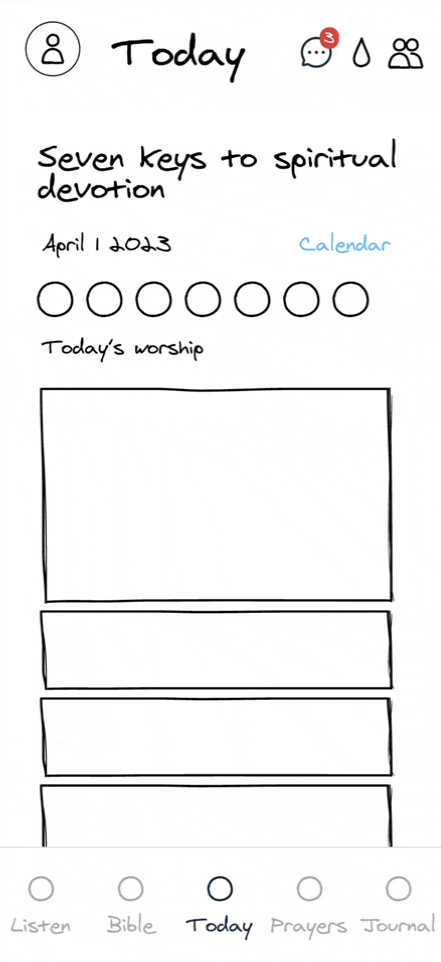
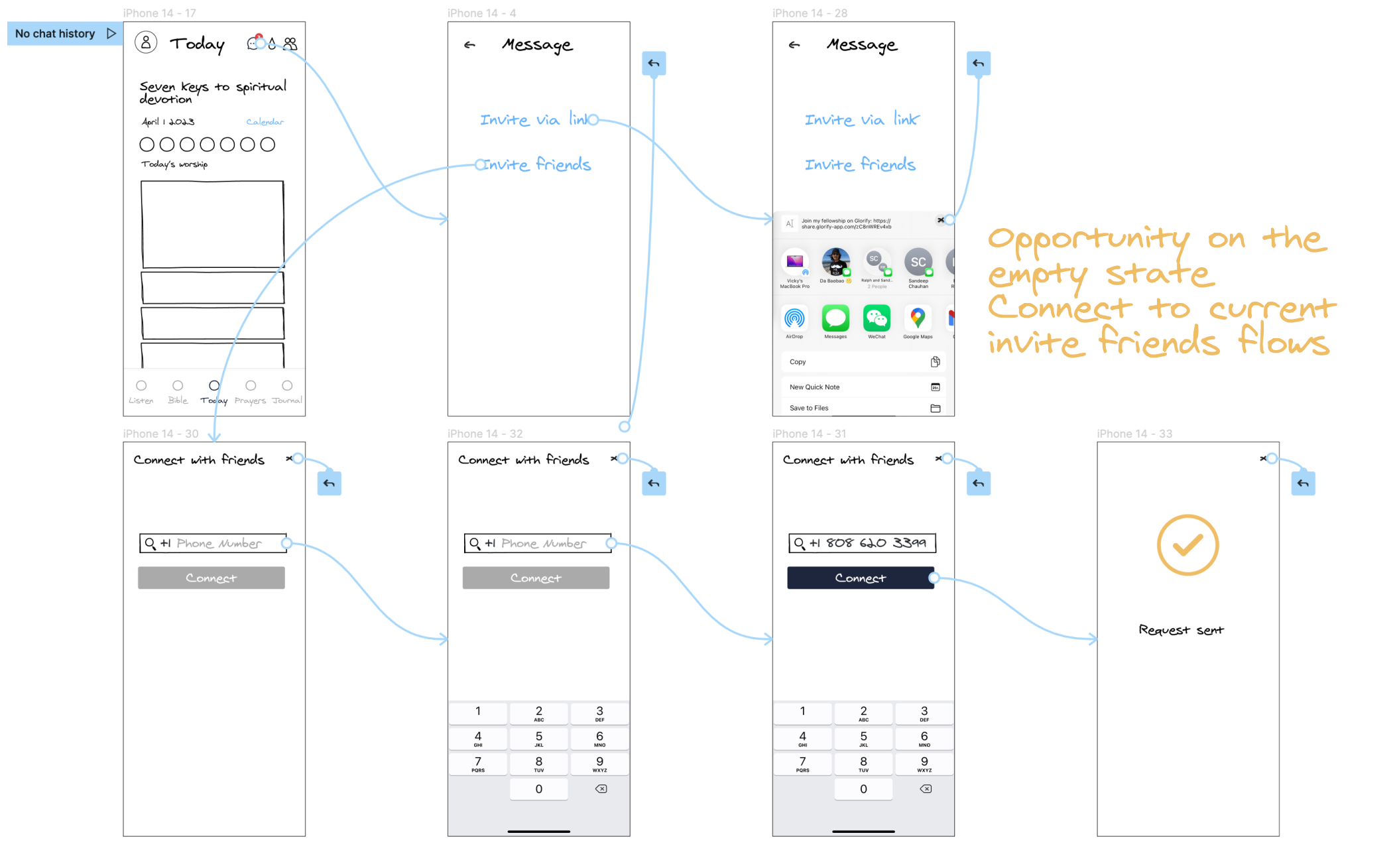
Organizing Content
Based on user feedback, navigating to the group prayer section isn't as straightforward as expected. At this point, I've come to understand that I should have conducted tree testing earlier in the process.
Moderated Tree Testing

Tree Test Plan for Group Prayer Navigation Update
Objective
To evaluate the intuitiveness and efficiency of the updated navigation structure in the app for creating and joining group prayers.
Participants
3
Methodology
The tree testing will be conducted remotely. Participants will be given specific tasks to complete using a simplified version of the app's structure (tree), devoid of any visual design elements.
Test Environment
- Participants will access the tree test online, using their computer or mobile device.
- The tree will be represented textually, without any design elements or actual functionalities.
Schedule
Conduct the tree test over 2 days, allowing participants to complete it at their convenience within that timeframe.
Tasks & Metrics
Tasks
- You want to create a custom prayer for your group. Where would you go to initiate this process?
- You wish to join an ongoing group prayer. Where would you go to find such prayers?
Metrics
- Success rate: Percentage of correctly completed tasks.
- Time on task: Time taken to complete each task.
- Click path: The series of choices (clicks) made by each participant.
- User Feedback: Any comments or suggestions by the participants.
The Tree
List out a high level organization, have participant click through the menus
| A | B | C | |
| Listen | |||
| Bible | |||
| Today | |||
| Prayers | Shared | Group prayer | Quick start |
| Custom | |||
| Join | |||
| Send prayer | |||
| Send prayer request | |||
| Private | Pray | ||
| Response | |||
| Journal |
Analyze the Testing Results

 Create a custom prayer for your group
Create a custom prayer for your group
Successful Rate: 3/3



Average Time on Task : 35 seconds
Click Path: Prayers > Shared > Group Prayer > Custom
 Join an existing group prayer
Join an existing group prayer
Successful Rate: 3/3



Average Time on Task : 30 seconds
Click Path: Prayers > Shared > Group Prayer > Join
Confusion and Recommendations 
 Points of Confusion
Points of Confusion
- Participants indicated that the steps to create a custom group prayer felt excessive, although they were able to complete the task.
- The "Shared" step was confusing for the participants. They were uncertain about the need to click "Shared" in order to initiate or join a group prayer.
 Recommendations
Recommendations
- Review and simplify the navigation sequence for creating a custom group prayer to reduce the number of steps. This will make the navigation experience smoother and more straightforward.
- Consider renaming or reorganizing the "Shared" category to make it more intuitive for users who are looking to initiate or join a group prayer. This could involve changing the label to something more descriptive or moving the group prayer options to a more straightforward location in the tree.
 General Feedback:
General Feedback:
- Participants were generally able to accomplish the tasks but suggested that the sequence for creating a custom prayer and the "Shared" step could be streamlined for a more intuitive experience.
- The tree test results indicate that participants were able to successfully complete the tasks, but there was feedback suggesting that the "Shared" step was confusing and the steps for creating a custom group prayer could be optimized for a better user experience.
Content Update

| A | B | |
| Listen | ||
| Bible | ||
| Today | ||
| Prayers | Group prayer | Quick start |
| Custom | ||
| Shared | Send prayer | |
| Send prayer request | ||
| Private | Pray | |
| Response | ||
| Journal |
Wireframe Test 2
Wireframe Test Plan for Updated Group Prayer Design 
Tree Test Plan for Group Prayer Navigation Update
Objective
To evaluate the usability and intuitiveness of the updated wireframe with simplified group prayer flows and enhanced group prayer list features.
Participants
Three participants who are familiar with mobile apps and have some understanding of group prayers.
Methodology
- Moderated testing of clickable wireframes in Figma.
- Remote testing, where participants will be given a set of tasks to complete.
Test Environment
- Participants will access the Figma prototype on their computer or mobile device.
- Remote conferencing tools will be used for moderated sessions.
Schedule
Conduct the wireframe testing over 2 days, allowing participants to complete it at their convenience within that timeframe.
Tasks & Metrics
Tasks
- Create a custom prayer for your group using the updated interface.
- Join an existing group prayer using the updated interface.
Metrics
- Success rate: Percentage of correctly completed tasks.
- Time on task: Time taken to complete each task.
- Error Count: Number of errors made during each task.
- User Feedback: Qualitative feedback about the experience.
Analyze the testing results 
 Create a custom prayer for your group
Create a custom prayer for your group
Successful Rate: 3/3



Average Time on Task : 25 seconds
Error Count: 0
 Join an existing group prayer
Join an existing group prayer
Successful Rate: 3/3



Average Time on Task : 13 seconds
Error Count: 0
Confusion and Recommendations 
 Points of Confusion
Points of Confusion
- No points of confusion were identified in this round of testing.
 Recommendations
Recommendations
- Continue monitoring user behavior as the features are rolled out to ensure that the simplification has improved the user experience as intended.
 General Feedback:
General Feedback:
- Participants found the new layout and simplified steps for creating and joining a group prayer to be straightforward and intuitive. The added details in the group prayer list, such as the description and the number of people waiting to pray, were highly appreciated for providing more context.
- The wireframe test results show an improvement in user experience based on the metrics measured. The simplification of the group prayer flow and the enhanced group prayer list were well-received by the participants, suggesting that the updates were successful.
Enhance
The high-fidelity prototype is designed based on user research to address specific needs: fostering shared faith, mutual understanding, support, and opportunities for connection. We'll test and fine-tune these aspects to ensure an effective and engaging user experience.
Hi-fi Prototype
Overall flow 
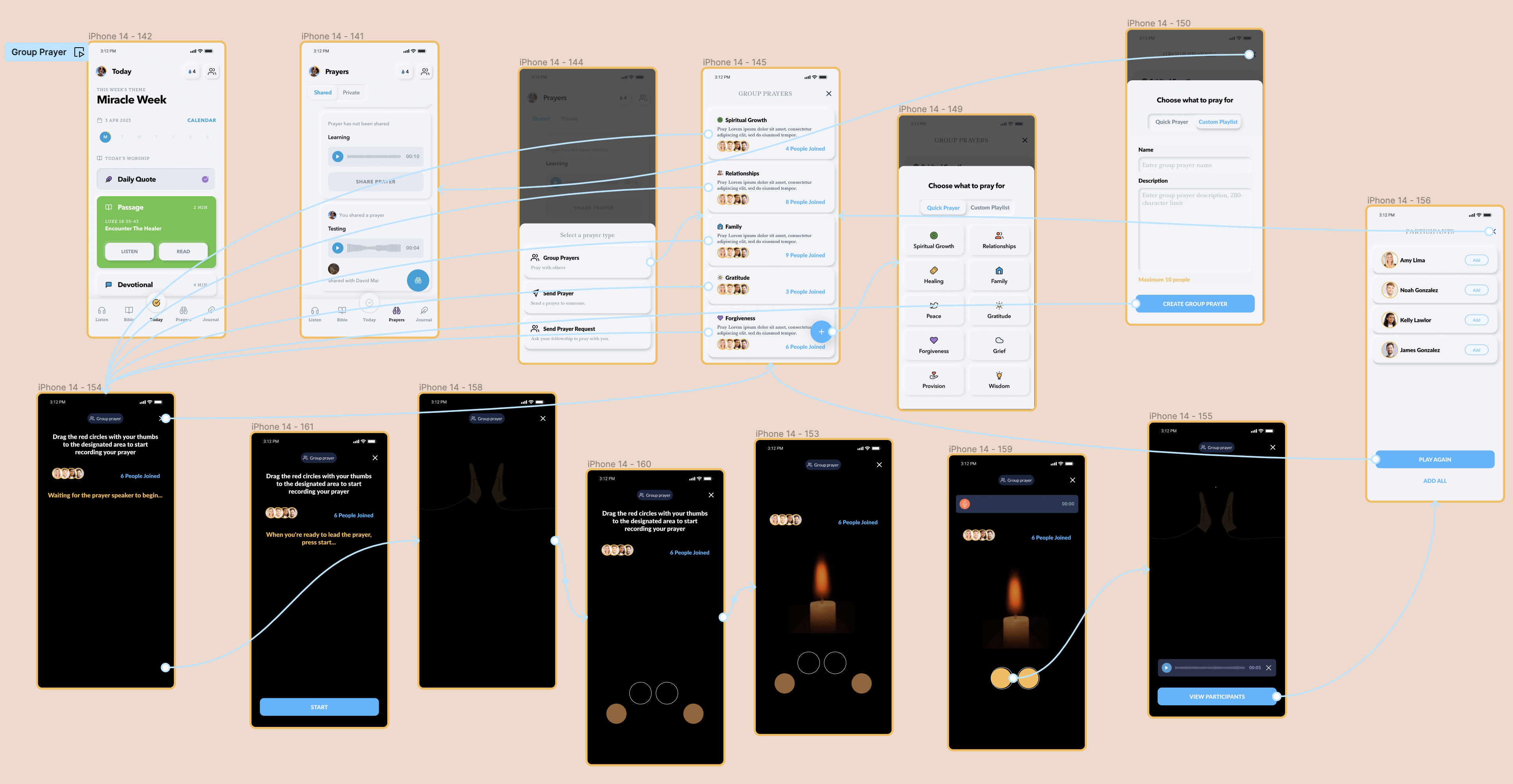
Hi-Fi Prototype Test
High-Fidelity Prototype Testing Plan for Group Prayer Interaction
Testing Plan for Group Prayer Interaction
Objective
To assess the effectiveness, usability, and emotional impact of the high-fidelity prototype in fostering smooth interactions during group prayer and enhancing the sense of community and shared faith among users.
Participants
Three participants who are familiar with mobile apps and have some understanding or interest in group prayers.
Methodology
- Moderated, remote user testing using the high-fidelity prototype.
- Video conferencing tools for moderated remote sessions to observe users as they interact with the prototype.
Test Environment
- The high-fidelity prototype hosted on a prototyping platform accessible via a web link.
- Remote conferencing tools will be used for moderated sessions.
Schedule
Conduct the high-fidelity prototype testing over 2-3 days, allowing participants to complete it at their convenience within that timeframe.
Tasks & Metrics
Tasks
- Create a group prayer session using the high-fidelity prototype.
- Join an existing group prayer session.
- Progress through the prayer session, engaging with the interactive elements designed to foster a sense of togetherness.
Metrics
- Success rate: Percentage of correctly completed tasks.
- Time on task: Time taken to complete each task.
- Emotional Impact: Qualitative feedback to gauge the sense of togetherness and community.
- User Feedback: Overall satisfaction with the experience.
Analyze the testing results 
 Create a group prayer
Create a group prayer
Successful Rate: 3/3



Average Time on Task : 24 seconds
 Join an existing group prayer
Join an existing group prayer
Successful Rate: 3/3



Average Time on Task : 18 seconds
 Praying Progress
Praying Progress
Successful Rate: 3/3



Average Time on Task : Varied depending on the prayer length, but all were successful
 Emotional Impact
Emotional Impact
- All participants reported feeling a heightened sense of community and shared faith, stating that the interactive elements added a meaningful layer to the prayer experience.
 User Satisfaction
User Satisfaction
- All participants expressed high satisfaction, appreciating the easy-to-navigate interface and interactive elements designed to foster a sense of togetherness.
 Points of Confusion
Points of Confusion
- No significant points of confusion were reported in this round of testing.
 Recommendations
Recommendations
- Consider adding more interactive elements based on the positive feedback about those currently included.
- Monitor user behavior and feedback as the features are rolled out to a wider audience.
 General Feedback:
General Feedback:
- The high-fidelity prototype was well-received by the participants, achieving the intended objectives of fostering smooth interactions and a heightened sense of togetherness during group prayers. The design elements aligned well with the user research goals of community power and shared faith, establishing an effective way for users to connect.
Enhancement
Group Prayer Experience Comparision 



Hi-fi prototype



Enhancement
Outcomes
After working mainly on productivity apps, this is my initial venture into creating Faith-based Community Apps. This project has opened new doors for me into the world of spiritual social networking.
As an individual and conceptual project, it has been a comprehensive learning journey for me. I've gone through the entire case study process, from developing research and test plans based on user and product needs to conducting interviews, iterating designs, and then repeating the process. Each iteration has brought different focal improvements.
Through qualitative feedback, I've gained important insights into what users want and need. Additionally, I've set up key metrics like average time spent on the app and error rates to objectively evaluate design choices. Both qualitative and quantitative data are guiding continuous improvements.
While this product is just a concept, there are still takeaways!
What went well so far 
User Engagement:
Test results have indicated that users are highly engaged with the group prayer feature and particularly appreciate the interactive elements during group playing.
Ease of Navigation:
Users found the navigation to the group prayer section intuitive, and the time taken to reach this section was within acceptable limits.
Ease of Joining Existing Group Prayers:
The process for joining existing group prayers received positive feedback, indicating the feature is very easy to use
What could be improved 
Streamlining Group Prayer:
Refine the process for creating and join a new group prayer. This could involve simplifying certain steps or providing clearer instructions to enhance the user experience.
Detailed Guidance:
While users found the general navigation intuitive, some indicated that more detailed guidance could be provided for creating new group prayers. Providing clearer instructions or tooltips might help improve this.
Enhancing Interactive Features During Waiting Time:
While interactive features were appreciated, they could be expanded to provide a more engaging and enriching experience to users during the waiting period.
Enhancing Search & Invite Functionality:
Develop a search function and incorporate an invitation feature for group prayers, enabling users to discover appropriate group prayer sessions and invite friends to pray together.
Learnings 
Qualitative versus Quantitative Data:
During this study, we relied heavily on qualitative data gathered through interviews and tests due to time constraints. While this provided valuable insights into the user experience and perceptions, it did limit our ability to draw wide-reaching, statistically significant conclusions. Moving forward, incorporating more quantitative data through surveys or larger-scale usability tests would provide a more holistic view of the user experience and help us to validate the insights gained from the qualitative data.
Understanding the Concept of Community:
Given the time constraints, we defined community as a "shared faith, mutual understanding, support, and the opportunity to connect with others." This was a suitable starting point for our study. However, the concept of community, especially within a religious context, is multifaceted and richly layered. If we had more time, it would have been beneficial to delve deeper into understanding the nuances of the Christian community from a social, psychological, and cultural perspective. This deeper understanding could inform more empathetic and holistic design decisions.


